Cargo theft and fraud is a common topic in many circles these days. No matter where we look, we see it mentioned in news headlines and see its impacts on price increases on the store shelves. In fact, CargoNet recently shared data showcasing that cargo theft has reached a 10-year high, increasing 59 percent year-over-year (YoY) in the U.S. alone.
While cargo theft and fraud have always been a risk in the world of logistics, the kind of theft and fraud we see today is evolving from what we used to know. Years ago, common cargo fraud involved extortion attempts via loads held hostage as well as t-check scams, where bad actors would book shipments and ask for a fuel advance, take the money, and disappear, often without completing delivery or even picking up the shipment they received the payment advance for.
While these kinds of fraud still occur, they are not as prevalent as they once were. Today’s cargo theft and fraud involve new strategies, and it’s important that companies stay aware of emerging tactics and remain vigilant to protect themselves from unnecessary and tragic losses.
The Evolution of Cargo Theft and Fraud
In the past, cargo theft was commonly known as the act of stealing from a truck or even unlawfully taking cargo from a storage facility. Usually this might occur when the truck driver was asleep or when the parked truck was left unattended in an unsecured lot. Now, cargo theft claims for lost product can be especially difficult to navigate as many insurance carriers have specific language and exclusions written within the pages of cargo policies limiting circumstances under which they will cover cargo payment for cargo theft incidents.
For example, some policies may dictate that the truck must travel within a specific radius only and cannot be left unattended unless in a secured lot. Unfortunately, the definition of “secured lot” is wide-ranging and debatable. Does “secured lot” mean there’s a locked fence, good lighting, cameras, surveillance, or a physical security employee on patrol? There’s simply a lot of confusion and unknowns when it comes to cargo theft in general.
The Federal Trade Commission (FTC) recently reported that the top scam type for 2023 involved imposters. We in logistics and other sectors have been experiencing this concept. Scenarios expand beyond just plain and simple identity theft, at least in the logistics industry. The current phase of cargo theft involving identity misappropriation is very strategic. In fact, CargoNet also shared data that strategic theft has increased 430 percent year-over-year (YoY). As quoted by Scott Cornell of Travelers Insurance, “Strategic theft is when they use various means to trick you into giving them the freight and that’s through methods like identity theft, fictitious pickups, double brokering scams, those methods are where we’re seeing the biggest increase over the last 18 months.”
This strategic cargo theft makes incidents that were already puzzling that much more difficult to solve. This kind of cargo theft often spans over multiple state lines (interstate) as opposed to intrastate. When this occurs, jurisdiction is not given to local or state authorities but may extend to federal jurisdiction. However, to establish a case seeking federal help, not only would more than one state need to be involved, but the cargo value must warrant federal attention to exceed $100,000 and perhaps even $500,000 or more, depending on the states involved. You may have police consider strategic cargo theft a civil matter that will not be taken under investigation.
Further, with these scenarios, there is confusion concerning who takes or issues the theft report Should that be the shipper, the receiver, or the freight broker? Is the report filed with law enforcement jurisdiction at the origin where freight was often last seen, or should reports be filed at the delivery jurisdiction, where the cargo never arrived? The cargo owner may attempt to file a police report where the transfer of goods occurred, which is the location where the driver took possession of the cargo for transport.
The State of Strategic Cargo Scams
Certain states like California and Texas have become hotspots for these strategic cargo scams, often involving imposter identities. Many of these fraudsters operate outside the U.S., finding and exploiting weaknesses in the system so products may end up outside the country. This further hurts the U.S. economy when items are produced here and those companies don’t get a financial return, thus losing money that should be going back into the economy. There are other additional costs affecting manufacturers to consider, such as lost time, materials, and labor to duplicate the goods that were originally stolen.
The Federal Motor Carrier Safety Administration (FMCSA) system, originally designed to verify motor carrier legitimacy, has become a target. Phishing scams and other methods have targeted carriers with a motive to change a carrier’s contact information and use their MC authority for nefarious purposes. Bad actors have been caught posing as valid, reputable carrier companies. They often go as far as creating web domains similar to those of established carriers or caught purchasing MC numbers from those going out of business or wishing to exit, especially with the recent market slowdown, with the new buyer updating that company’s contact information. They look and “run” as the previous motor carrier, using that previous authority and reputation to run their scams. This facade allows them to gain possession of or intercept the cargo and divert it to a pre-arranged location for a quick disappearance. The FMCSA is aware of these trending cargo theft scams and is actively looking to improve their vetting and even get rid of MC numbers for carriers.
There’s also a prevalence in double brokering. This is when an unauthorized carrier accepts a shipment or assigns it to another carrier lacking the proper authority to broker it in the first place. It can also involve the re-brokering of shipments without authorization to legitimate entities with broker authority. This creates a chain of uncertainty and lack of control over carrier selection while increasing the likelihood of unpaid delivering carriers, and double payments required from freight brokers and shippers, paying more than agreed for delivery services.
Load boards, while usually valuable tools for shippers and freight brokers to connect with available carriers, are also now breeding grounds for fraud. Fake postings and compromised information have created a haven for scam artists. The more information presented on a load posting, such as commodity, value, or even location, the more opportunity for these scammers to successfully replicate fake loads and even steal rate confirmations from legitimate actors. Detailed information provided on load boards make loads easier targets for those with motive to engage in strategic theft and double brokering.
Cargo fraud involving identity theft is not limited to carrier companies. Scammers also pose as shipper companies. These shipping requests will often come in as inbound leads rather than relationship leads. Scammers create fake web domains and use reputable companies to gain credit access, then use that access to pose as both a shipper and carrier. They’ll orchestrate this fake shipment of theirs, make it look as if it has been delivered with forged paperwork, and collect payment before being found out.
A lot of these shipments involving strategic cargo theft end up being diverted to alternate warehouses. In these cases, it is common for the carrier booked to be legitimate but for a bad actor to somehow get in the middle and divert the driver to deliver to a different location altogether, promising an increase in money. Once the freight arrives at the alternate location, there’s a truck en route or waiting to whisk away the freight quickly. Diverted items do not stay in one place for long, making it difficult to track and recover the cargo.
How to Be Proactive and Prevent Cargo Theft and Fraud
Trust, But Verify
Whether dealing with a shipper company or carrier, thorough verification is needed.
For shippers requests, use sources like ZoomInfo, LinkedIn, and Google. Research the company along with the contact who reached out. Remember that most shipper scams involve inbound leads as opposed to solicited new business or existing relationships. Before agreeing to arrange or transport the movement of goods, use Google Maps to ensure the requested pickup and delivery locations are legitimate.
For example, if the shipping company is a well-known business but Google Maps Street View shows you a location that doesn’t look like one of theirs, something might be off. Another red flag could be if the commodity to be shipped doesn’t line up with their standard business, such as an electronics company trying to ship lumber or rice.
For carrier requests, first vet that they have authority to operate with the FMCSA. View their safety rating and be cognizant of shipper or load-specific requirements, such as drivers who have TWIC cards, and commodity specifics, like cargo type and value. Confirm the carrier has adequate insurance coverage for the shipment they are booking, such as reefer breakdown coverage, if they are to haul a temperature-controlled shipment. Cross-check any other shipment requirements, such as interstate authority or hazmat certifications.
Review relationship and load history if they have a shipment history with you and ensure the new request lines up with previous hauls. Be aware of MC misappropriating. Check if the FMCSA information or profile has recently been updated. Some things to look out for are contact, address, or email address changes. Double-check that the carrier company is not associated with any known bad actors and adhere to your company’s own internal vetting standards.
There are various informational and vetting applications like Highway and Truckstop to further qualify carriers. Ensure the equipment the carrier owns lines up with the equipment required for the shipment. For example, it wouldn’t make sense if a carrier books a temperature-controlled shipment when the carrier owns no refrigerated trailers.
Use Relationships, Limit Load Boards
While load boards offer convenience, strong relationships with carriers provide a significant advantage. Building trust and gaining a deeper understanding of their business reduces your risk of cargo theft and fraud.
When load boards are needed, be strategic with your postings and focus on the security of the information you share. Scam artists often use load boards as a resource for information to replicate or find their next victim. They often look at the locations, the kind of cargo, and more. Avoid posting detailed descriptions of your cargo. Keep the information you share as simple and minimal as possible. Protect that information until the carrier has been both vetted and confirmed.
Trust Your Gut
If something feels wrong at any time, report it to your Risk Team or dedicated personnel right away. With cargo theft, time is of the essence. The first 48 hours are critical as stolen freight typically doesn’t stay in the same place very long. Your best chance of recovering it is within those early hours of noticing it.
Your first line of defense to prevent cargo theft and fraud incidents is your pickup location. Those workers have the eyes and, hopefully, surveillance to see if the truck coming in is the right one. They can check that the MC on the truck is correct, that the driver has the right equipment for that shipment’s requirements, that the driver is the one booked, and that they know the correct location they need to deliver to.
Shippers can also be proactive and place trackers in with their freight, which can be beneficial for trip progress tracking as well if the load gets stolen. While many carriers do have trackers these days, it’s best not to rely solely on them. Scam artists have been known to disable trackers or ping them to another cell phone, making the shipment look like it’s traveling where it is supposed to go, while it is, in fact, stopped or delivering to an alternate location.
Shippers can also ensure they use strong seals that are tamper-proof. Ensure your dock workers are informed and proactive in reducing potential incidents. Shippers may also consider investing in extra shipper’s interest for its product, for a first-party insurance policy which provides a layer of extra protection. Develop strong relationships with the freight brokers you work with. Know who the emergency personnel are on the shipper and broker side and be armed with their contact information so you know exactly who to contact at all times of the day should a theft or another emergency occur during shipping.
Knowledge is Power
Stay in the know of what’s going on and trending in cargo theft and fraud by networking with known associations, like CargoNet and the Transport Asset Protection Association (TAPA), as well as the additional connection of the Transportation Intermediaries Association (TIA) for freight brokers. These organizations constantly educate on evolving threats to keep members aware.
Ensure you have an emergency plan in place and educate your team so you can be well prepared for an incident. Develop relationships with law enforcement and investigation agencies who can help you put the word out about your loss and assist in finding your freight or the scam artists involved.
Combatting Cargo Theft is a Shared Responsibility
Combatting cargo theft and fraud requires collaboration from all within the logistics industry. Shippers, brokers, carriers, legislators and law enforcement must work together to create a more transparent environment with strict accountability to make it more difficult for thieves and fraudsters to operate.
Cargo fraud is growing, and tactics are ever-changing. Even with all the right measures in place, fraud may not be 100 percent preventable. That said, though we can’t stop it all, we can implement not only prevention measures but response strategies. By staying vigilant and educated, we can collectively demonstrate to these bad actors that it’s not worth the effort anymore. It is up to us to create a future where the movement of goods is more efficient and secure than it is today.
Get More Content Like This In Your InboxAbout the Author

Kristin Deno currently holds the role of Director of Operational Risk at Trinity Logistics. Deno holds a Certified Cargo Claims Professional certification through the Certified Claims Professional Accreditation Council (CCPAC), with almost 15 years of experience and knowledge in claims, insurance, compliance, and risk. She has a passion for knowledge and servant leadership, always looking to grow professionally and share her expertise to those interested. She’s well known at Trinity for assisting fellow Team Members, Shippers, and Carriers with complex claims and doing all she can to mitigate any potentially concerning scenarios. Deno consistently looks for opportunities to share her knowledge and insight outside of Trinity, having recently attended the TIA’s 2023 Policy Forum in Washington, D.C., Traveler’s and CargoNet’s Cargo Theft and Transportation in Q4 2023, and the TAPA T1 National Cargo Theft Summit in May 2024.
Stay up to date on the latest information on conditions impacting the freight market, curated by Trinity Logistics through our Freightwaves Sonar subscription.
FREIGHT VOLUMES ARE ACTUALLY UP
It seems much of the news clippings have been around freight rates and how they remain suppressed. One could jump to the conclusion that this is a result of freight volumes being down. On the contrary, freight volumes are elevated from what we saw in 2023.
As you can see in Figure 1.1, volumes for the majority of 2024 are between six to eight percent higher compared to 2023. What is driving (or not driving) rates remains the capacity in the market.

Capacity is showing a net decline, albeit slower than expected. Much of that reduction is being felt in the less-than-10 tractor-fleets, so while the number of for-hire carriers is declining, the impact to actual trucks to haul freight is a slow drip.
That capacity continues to hold tender rejection rates at extremely low levels, meaning few loads are hitting the spot market. As a result, spot rates remain almost $0.70 per mile less than contracted rates. There has been some closing of the gap over the past year, as shown in Figure 1.2, but look for the gap to remain relatively consistent for the remainder of the year.

The Aftermath of The Francis Scott Key Bridge Collapse
It has been about six weeks since the bridge collapse in Baltimore. Removal efforts continue and certainly, a return to normal traffic flow is years away.
In positive news, looking at the *headhaul index for that market (Figure 1.3), aside from the drop around the time of the collapse, things appear to be back to normal from a balance standpoint. Certainly, there are more out-of-route miles and freight that may be entering at nearby ports, but for the most part, outbound and inbound freight volumes appear to be back to normal for the Baltimore market.
*headhaul measures the variance in outbound versus inbound freight

Stay Up To dAte
Looking for a more frequent update? Subscribe to our newsletter and receive the top five logistics articles of the week every Friday morning by selecting “Weekly News Update” when you select your preferences.
Get Weekly News Updates in Your InboxYou can consider drayage service the unsung hero of shipping. It’s crucial to global supply chains, bridging the gap for both intermodal and international shipments.
Growing businesses often develop a need for drayage services but can easily get overwhelmed by it. Unlike truckload or less-than-truckload (LTL), getting your items picked up and delivered with drayage shipping sometimes isn’t a straightforward process. From port congestion to demurrage, it’s easy to get lost in the tangled process of drayage. Yet, with a few quick tips and the right approach, you can make use of drayage services to your supply chain’s advantage.
What ARE COMMON CHALLENGES WITH DRAYAGE? How Can I avoid Them?

Route Planning
One of the primary challenges faced by shippers handling drayage services is route planning. Ports and rail terminals often operate in congested cities with lots of traffic and frequent road closures. Poor route planning can lead to delays, missed appointments, increased fuel consumption, additional fees, and, most of all, frustrated customers.
Chassis/Equipment Shortages
Just like there can be ebbs and flows with truck trailer capacity, drayage brings the concern of its own equipment shortages. Chassis are what the containers sit on when hauled by the carriers. It’s important to mention that drayage carriers don’t own chassis. Instead, they rent the chassis from the port or terminal, thus adding an additional complexity to drayage services. Chassis shortages most often happen during peak shipping seasons and can create delays or additional costs for shippers.
Port or Terminal Delays
Delays can happen at the ports or terminals for several reasons. Unforeseen events like canal blockages (Suez Canal), the Francis Scott Key Bridge collapse, or possible rail strikes have most recently created delays for shippers. Customs clearance is often the most common cause of delays as the process can be intensive, and any improper documentation or misclassified products can cause a holdup. Container reshuffling can also be an issue from time to time when there are too many containers, whether full or empty, at the ports or terminals.
Additional Charges
Additional charges may be the bane of drayage services, second to delays. Drayage can come with many accessorial fees that can catch shippers off guard if not prepared. The most common fee you’ll hear about in drayage services is demurrage.
Once a container is delivered to the port or terminal, you’re given a set number of “free days” for it to be picked up by a drayage carrier. This is called your Last Free Day (LFD), and that’s the date you want to ensure your container is picked up so you won’t face this additional charge.
There are also drop fees. Drop fees are for when the drayage carrier must drop the container and then come back to pick it up and return it empty to the port or terminal.
Lastly, if the empty container is returned late to the port or terminal, that’s an additional fee.
Lack of Transparency or Communication
With drayage services, you really need to have a clear picture of what’s happening if you want to reduce the chance of accruing any additional charges, not to mention any delivery delays or customer dissatisfaction. Effective communication between shippers, carriers, logistics providers, and port or terminal authorities is essential for smooth drayage shipping.
TIPS TO Avoid DRAYAGE SERVICE CHALLENGES
If you’ve experienced any of the previously mentioned challenges with drayage service, the great news is there are really only two tips you need to make it seamless.
Proper Planning and Time Management
Most of the challenges with drayage are caused by improper planning, unforeseen circumstances, or misinterpretation at the port. Proper time management and planning are essential to avoid those challenges in the first place. Ensuring you have properly evaluated and documented your freight, selecting the right drayage carrier based on your needs, and taking into consideration factors like port or terminal timings or traffic.
Additionally, stay in the know of what’s going on in the market. Are there any anticipated delays or disruptions that could change your plans? Do you have a contingency plan in place should an unforeseen event occur? The more planning you’ve made ahead of your drayage shipment, the better your supply chain will operate.

Work with the Right Drayage Provider
Working with the right provider can significantly impact the success of your drayage service. While that tip is easy to state, how do you determine if a provider is the right one for your needs?
When searching for a drayage service provider, you should ensure they:
- Gain you access to reliable capacity with experienced carriers,
- Offer excellent customer service and clear and timely communication,
- Technology tools to provide you with shipment visibility and tracking,
- Accurate billing practice,
- And has a high on-time delivery percentage.

By prioritizing these characteristics when looking for a drayage service provider to work with, you’ll quickly find that selecting the right one will improve your company’s competitiveness and service by helping you overcome these common challenges.
WORK WITH TRINITY FOR The Best DRAYAGE SERVICES
Speaking of reliable drayage service providers, you’re currently hot in your search already!

Trinity Logistics is a nationwide, top-rated third-party logistics (3PL) provider capable of helping you overcome any challenges you’ve been facing with your drayage service. You should consider us because:
Trustworthy Carrier Relationships
We treat and respect our carrier relationships and aim to build a strong partnership with each one to help their businesses be successful. Because of that, we’ve built trusted partnerships with those in our carrier network, gaining you access to the capacity you need and the service you want.
24/7/365 Support
No matter what happens, we’re ready to support you around the clock. We have a dedicated After-Hours Team to continue the monitoring of your freight and are ready to quickly resolve potential challenges, no matter the time of night, holidays, and every weekend.
Tracking and Tracing
We understand transparency is key to your drayage success, so we offer several ways to view and keep track of your freight, no matter the time of day.
Team of Experts
Our only job is logistics. It’s what we handle day in and day out. We’ve been working in this industry for 45 years and have seen all the ups, downs, delays, and disruptions the freight market has thrown at us, so we know how to handle tough situations. Additionally, we stay knowledgeable about what’s going on and keep you informed of anything that could come your way, with a backup plan at the ready.
Clear Communication About Charges
From the start, we are transparent about costs and help you understand all the different charges that you may see or come across with drayage service.
Your Trinity relationship will provide a list of any potential charges that may arise, such as any overweight, drop, or hazmat fees. Our goal is to ensure you know exactly what to expect so there are never any surprises.
An additional benefit to our trusted carrier relationships is our capability of keeping any fees from the port tied to the clearance of any containers from being billed back to you and being able to be competitive with those drayage rates.
Yes, drayage services can be complex and challenging at times, but it doesn’t have to be if you choose to work with Trinity Logistics.
I WANT TO KNOW MORE ABOUT TRINITY’S DRAYAGE SERVICEStay up to date on the latest information on conditions impacting the freight market, curated by Trinity Logistics through our Freightwaves Sonar subscription.
FRANCIS SCOTT KEY BRIDGE IMPACT
Watching the video of the bridge collapse was surreal. To have that structure there one minute, then five seconds later be completely gone, was jaw-dropping. Certainly, our thoughts and prayers are with those whose lives were impacted by the collapse.
Since the incident, clean-up has begun and a temporary waterway has been established, but it will take a while for the port to fully recover, let alone the bridge itself to be rebuilt. While the 30,000 plus vehicles that regularly cross that bridge is a sizable number, it’s about one-sixth of the volume that uses nearby major thoroughfares like I-695 or I-95 in the Baltimore area. Still, that traffic will need to go somewhere.
From the trucking side, there will likely be two main areas of impact. First, local freight that is destined for ocean travel will now need to find another port of departure, likely destinations the ports of NJ/NY; Philadelphia; and Norfolk, VA. This means more freight will be heading out of the Baltimore area.
Figure 1.1 below shows that since the end of March, right around the time of the bridge collapse, outbound volume, and freight tender rejection rates, have trended upward. Second, freight that travels around the Baltimore area will likely incur more out of “normal” route miles if the bridge was part of its route.
More carrier miles = more time to deliver = less time for other freight = increased freight costs.

SOME BALANCE SEEN
Overall, freight volumes have trended slightly above 2023 (Figure 2.1).
This has not dramatically impacted freight rates nationally or freight tender rejection rates. Excess capacity continues its slow runoff, and March saw an uptick in for hire carriers.
On a more granular scale, flatbed freight seems to be more optimistic. As seasonal flatbed type freight, combined with an uptick in industrial production and manufacturing activity is occurring, it has pushed flatbed rejection rates to more normal levels over the past few months as seen in Figure 3.1.
Flatbed rejection rates reached their highest point in over a year recently, and a 15 percent rejection rate is indicative of a more balanced freight market, if only for a certain equipment type segment.
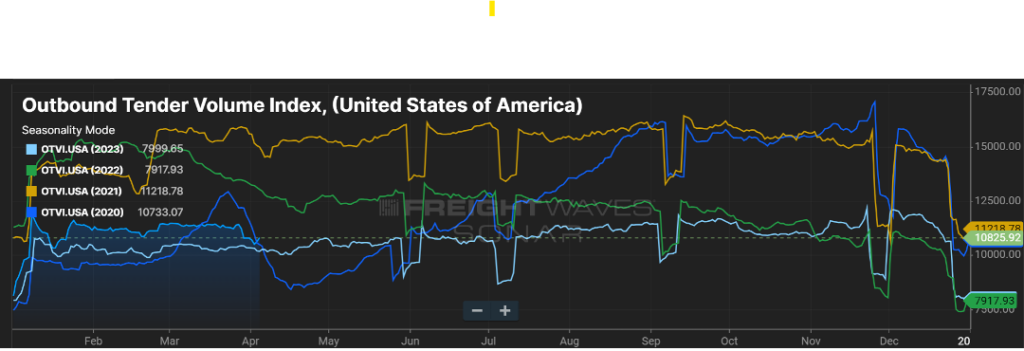

Stay Up To dAte
Looking for a more frequent update? Subscribe to our newsletter and receive the top five logistics articles of the week every Friday morning by selecting “Weekly News Update” when you select your preferences.
Get Weekly News Updates in Your InboxTrinity Logistics, a leading third-party logistics provider (3PL), is proud to share its recognition by Transport Topics as a Top Freight Brokerage for the 22nd consecutive year. Securing the 23rd spot in the rankings, Trinity continues to demonstrate its industry-leading expertise and unwavering commitment to excellent service.
Transport Topics is a leading publication within the transportation sector and conducts annual rankings of freight brokerage firms based on gross revenue and services offered. Securing a spot on this list for 22 consecutive years is a testament to Trinity’s exceptional performance and endurance through several years of change faced by the logistics industry.
“We are incredibly honored to be recognized once again by Transport Topics,” said Doug Potvin, Chief Financial Officer at Trinity Logistics. “This achievement reflects the dedication and hard work of our entire Team, who consistently go the extra mile to ensure our customers’ and carriers’ success. Maintaining a top position for 22 years demonstrates the strength and stability of our company, and we are confident in our ability to continue exceeding expectations well into the future.”
Trinity Logistics continues to set the benchmark for excellence in the logistics industry, leveraging its extensive experience and innovative solutions to deliver exceptional value to clients worldwide.
VIEW THE COMPLETE LIST ON TRANSPORT TOPICS LEARN MORE ABOUT TRINITY LOGISTICSAbout Trinity Logistics
Trinity Logistics is a Burris Logistics Company, offering People-Centric Freight Solutions®. Our mission is to deliver creative logistics solutions through a mix of human ingenuity and innovative technology, enriching the lives of those we serve.
For the past 45 years, we’ve been arranging freight for businesses of all sizes in truckload, less-than-truckload (LTL), warehousing, intermodal, drayage, expedited, international, and technology solutions.
We are currently recognized as a Top 100 3PL by Inbound Logistics, and as a Top Company for Women to Work for in Transportation by Women in Trucking.
Trinity Logistics, a leading third-party logistics provider (3PL), is thrilled to announce that President Sarah Ruffcorn has been named the recipient of the prestigious Distinguished Woman in Logistics Award (DWLA) by the Women in Trucking Association (WIT). The announcement took place during the Transportation Intermediaries Association (TIA) Conference held in Phoenix, Arizona, April 10 -13, 2024.
The DWLA is an annual award that recognizes outstanding women in various logistics fields and underscores their significant contributions to an industry traditionally dominated by men. The winner is chosen by a selection committee comprised of representatives from WIT, Truckstop, and the TIA. Sarah’s win highlights her exceptional leadership and dedication to driving positive change within the logistics sector.
“I am truly honored to receive this award,” said Ruffcorn. “This recognition is a testament to the incredible Team I am honored to work with, the influential leaders, mentors, and family that have challenged and encouraged me. This is a great reminder of the power of collaboration and empowerment to drive positive change. I hope this award inspires others to pursue their goals and aspirations!”
With over two decades of experience at Trinity Logistics, Ruffcorn’s journey exemplifies her unwavering commitment and expertise. Starting as a dispatcher in Carrier Sales, she progressed through various leadership roles before being appointed President in 2019. Her visionary leadership has been instrumental in shaping Trinity’s success while fostering a culture of innovation and excellence.
“At my very first meeting with Sarah, I knew she was a special talent,” said Catherine T. Pulos, Executive Vice President and Chief Operations Officer at Wawa, Inc. “Sarah is an expert in the field of logistics and a true servant leader. She is humble, dedicated, and truly cares about the development of her people. She believes in making a difference and her actions certainly prove that.”
This latest accolade only adds to Ruffcorn’s growing list of achievements. In September 2023, she was a recipient of the 2023 Women in Supply Chain award by Food Logistics and Supply & Demand Chain Executive. Further, her dedication extends beyond Trinity Logistics as she is actively involved in industry advocacy and empowerment initiatives. Ruffcorn serves on the TIA Board of Directors and co-chairs its Women in Logistics Committee, advocating for diversity and inclusion with the logistics landscape.
“Sarah Ruffcorn is in a leadership class that very few women will occupy and is completely deserving of this prestigious award,” said James T. Kenny, Ph.D., Professor Emeritus of Marketing. “Many organizations have sought Sarah out to serve in leadership positions or speak at their conferences because they see what I’ve seen in Sarah for over twenty years: a woman of impeccable character.”
Ruffcorn’s recognition by WIT further amplifies the impact women are having on the logistics industry. All of Trinity congratulates Ruffcorn on this esteemed honor and celebrates her continued success.
LEARN MORE ABOUT TRINITY LOGISTICSAbout Trinity Logistics
Trinity Logistics is a Burris Logistics Company, offering People-Centric Freight Solutions®. Our mission is to deliver creative logistics solutions through a mix of human ingenuity and innovative technology, enriching the lives of those we serve.
For the past 40 years, we’ve been arranging freight for businesses of all sizes in truckload, less-than-truckload (LTL), warehousing, intermodal, drayage, expedited, international, and technology solutions.
We are currently recognized on Transport Topics’ Top 100 Freight Brokerage List, as a Top 100 3PL by Inbound Logistics, and as a Top Company for Women to Work for in Transportation by Women in Trucking.
Stay up to date on the latest information on conditions impacting the freight market, curated by Trinity Logistics through our Freightwaves Sonar subscription.
WILL 2024 BE A FREIGHT REBOUND YEAR?
I certainly do not expect that we will return to freight volumes like we saw in 2021, and part of 2022. Now, I will never say never, but those were most likely once in a lifetime events. However, there are many signs that point to a potential for 2024 to see a rebound in freight volumes and carrier rates.
First, let’s talk about rates for over-the-road (OTR) carriers. Many new entrants came to the carrier market in ’21 and ’22, but currently, we’re seeing the contraction of for-hire carriers.
As shown in Figure 1.1, the past 14 months have seen less carriers in the market. As supply continues to dwindle, this will put upward pressure on rates. Granted, it may take another 12 months for the carrier market to find an economic balance.
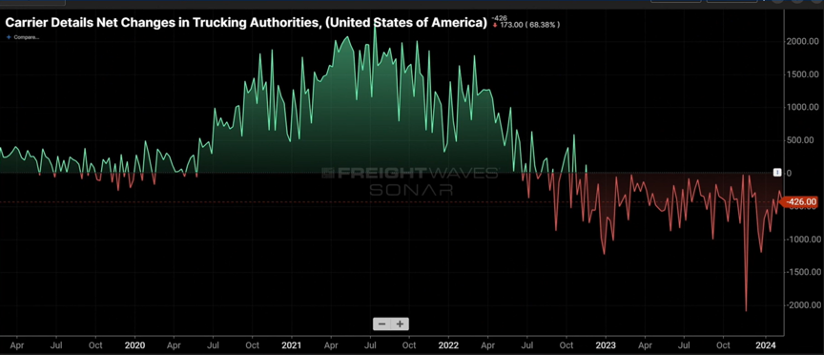
Figure 1.2 measures the rate at which carriers reject tenders (shipments) and continues to slowly climb upward. Granted, a rejection rate of five-plus percent is not earth-shattering, but in comparison to where it was in 2023, sub three percent in several months, five percent and the continuing upward movement is noticeable.
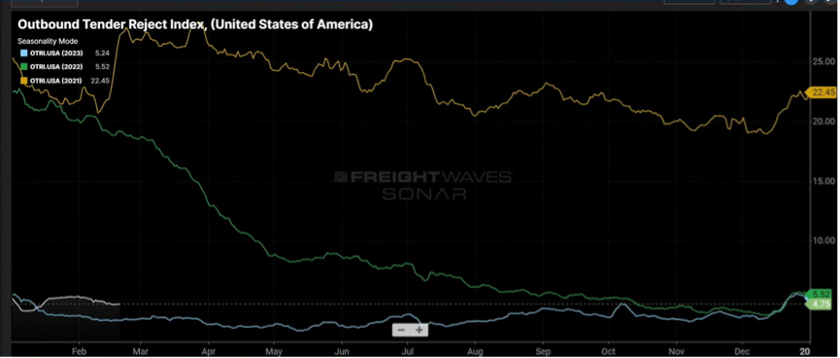
Lastly, Figure 1.3 shows that spot rates continue their slow rebound from the middle part of 2023. Contract rates throughout much of 2022 and half of 2023, were $0.60 to $0.70 cents per mile higher. Today, that gap stands at $0.36 per mile. This is a combination of spot rates inching higher, but also contract rates being less than prior years.
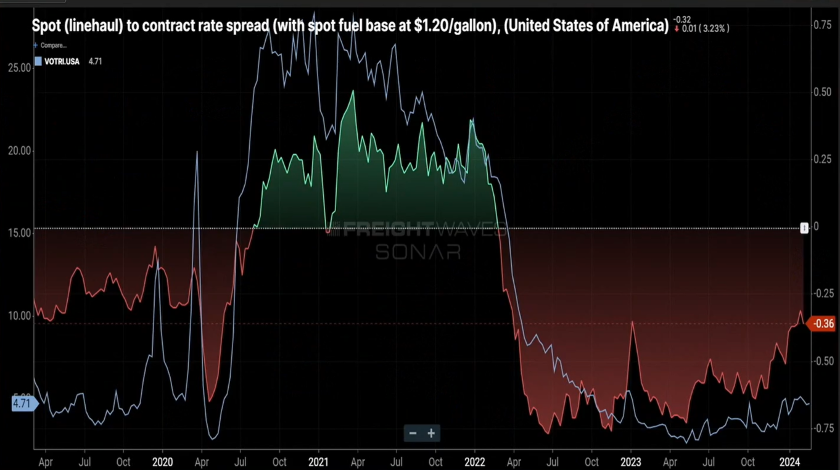
An Opportunistic Outlook
While contraction in the carrier market will influence the supply side of the economic equation, there also needs to be a demand component. The below chart (Figure 2.1) shows loaded rail car volume and over-the-road volume trending up and to the right, but the green line, representing inbound ocean containers, is really peaking.
Eventually, these containers will morph into rail and OTR volume. This is most likely a result in the drawing down of inventories, and the need for replenishment. Combine this with continuing increases in the manufacturing sector and housing market that will show better signs than 2023, it sets the stage for strong demand especially in the second half of 2024.
Will it be a bull or bear year in ’24? Well, if you would have asked that question six months ago, even maybe three months ago, my answer would have been slightly bearish or at best flat. However, seeing the recent signs on freight activity and the carriers needed to move this freight gives more reason to be optimistic as we go through the next ten months of the year.
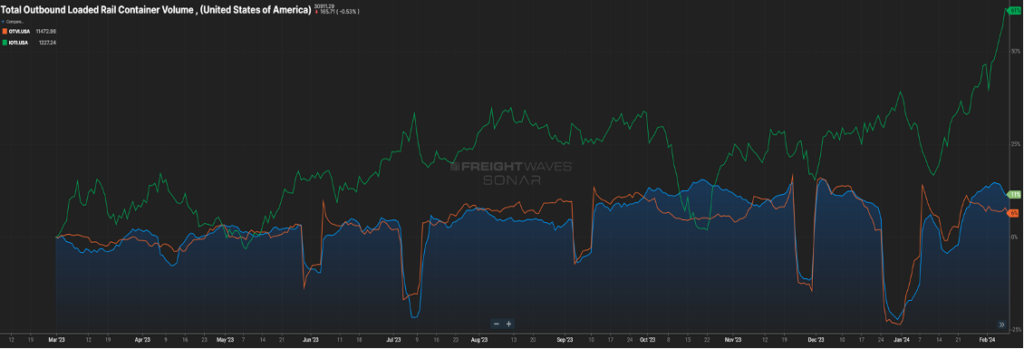
Stay Up To dAte
Looking for a more frequent update? Subscribe to our newsletter and receive the top five logistics articles of the week every Friday morning by selecting “Weekly News Update” when you select your preferences.
Get Weekly News Updates in Your InboxTrinity Logistics, a leading third-party logistics provider (3PL), is proud to announce that it has been honored with the prestigious “Fiercely Good Award” by BlueTriton Brands Inc., a prominent player in the beverage industry. The award was presented to Trinity Logistics during BlueTriton’s Annual Carrier Meeting, which saw the attendance of over 150 carrier and 3PL companies.
“The BlueTriton Brands, Inc. 2023 ‘Fiercely Good Award’ is to recognize our colleagues that embrace being fearless business owners, boldly innovative, deeply committed, and fiercely good,” said Tilde Zimmerman, Transportation Procurement Director at BlueTriton Brands, Inc. “In 2023, Trinity Logistics went above and beyond what was asked or expected of them. We like to appreciate and recognize the efforts of those who collectively make us better. Thank you for being FIERCELY GOOD, Trinity Logistics Team!”
Zimmerman specifically recognized Trinity Logistics for its exceptional commitment to service and its invaluable contribution to a community initiative spearheaded by BlueTriton Brands, Inc. Trinity Logistics played a pivotal role in facilitating the delivery of a much-needed donation of water by BlueTriton to support a local high school football showcase in Broward County, Florida, demonstrating its dedication to making a positive impact beyond the realm of logistics.
Delivering the donation posed unique challenges, including the absence of a loading dock at the school premises and the logistical intricacies of offloading the shipment directly onto the football field. Despite these obstacles, Trinity Logistics executed the task with precision and efficiency, ensuring the timely and seamless delivery of the water donation.
Representing Trinity Logistics at the event were Fatima Adams, Director of Operations at Trinity’s Florida Regional Service Center (RSC), and Jared Lineweaver, Senior Sales Executive. Their presence underscored Trinity’s commitment to fostering strong partnerships and delivering exceptional service.
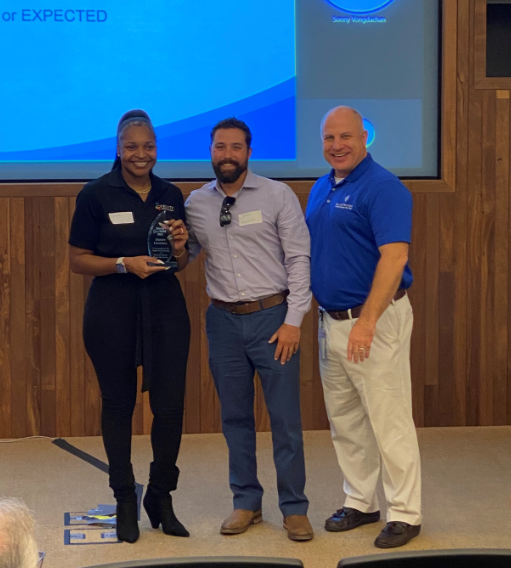
“We are deeply honored to receive the ‘Fiercely Good Award’ from BlueTriton,” said Adams. “This recognition stands as a testament to our unwavering commitment in providing exceptional service to our customer relationships. We are immensely proud of the solution our Team assembled and their dedication and resourcefulness in overcoming this challenging task.”
Trinity Logistics is grateful to BlueTriton Brands, Inc. for the recognition and remains steadfast in its mission to provide innovative logistics solutions while positively impacting the communities it serves.
LEARN MORE ABOUT TRINITY LOGISTICSAbout Trinity Logistics
Trinity Logistics is a Burris Logistics Company, offering People-Centric Freight Solutions®. Our mission is to deliver creative logistics solutions through a mix of human ingenuity and innovative technology, enriching the lives of those we serve.
For the past 40 years, we’ve been arranging freight for businesses of all sizes in truckload, less-than-truckload (LTL), warehousing, intermodal, drayage, expedited, international, and technology solutions.
We are currently recognized on Transport Topics’ Top 100 Freight Brokerage List, as a Top 100 3PL by Inbound Logistics, and as a Top Company for Women to Work for in Transportation by Women in Trucking.
After several record setting years, 2023 saw shifts to the freight market. How did the 2023 freight market affect shipper and carrier businesses? Did other businesses have the same struggles as yours? Are they expecting to face similar difficulties in 2024? How are their partner relationships?
Trinity Logistics wanted to get answers to these questions for you, so we asked a random sample of our shipper and carrier relationships to gauge the effect 2023 had on their business and what their expectations for 2024 in our first Freight Market Survey. Here’s what we found out:
2023 SHipper & Carrier Data: Freight Market Survey Results
Past Challenges – Same, But Different
Considering the recent turndown of demand and the freight market, it’s not a big surprise that money was the biggest issue for shippers and carriers alike. Shippers answered that transportation costs were their biggest challenge in 2023, with supply chain delays/disruption and capacity not far behind. Low rates and increasing operating costs were the main challenges facing carriers.
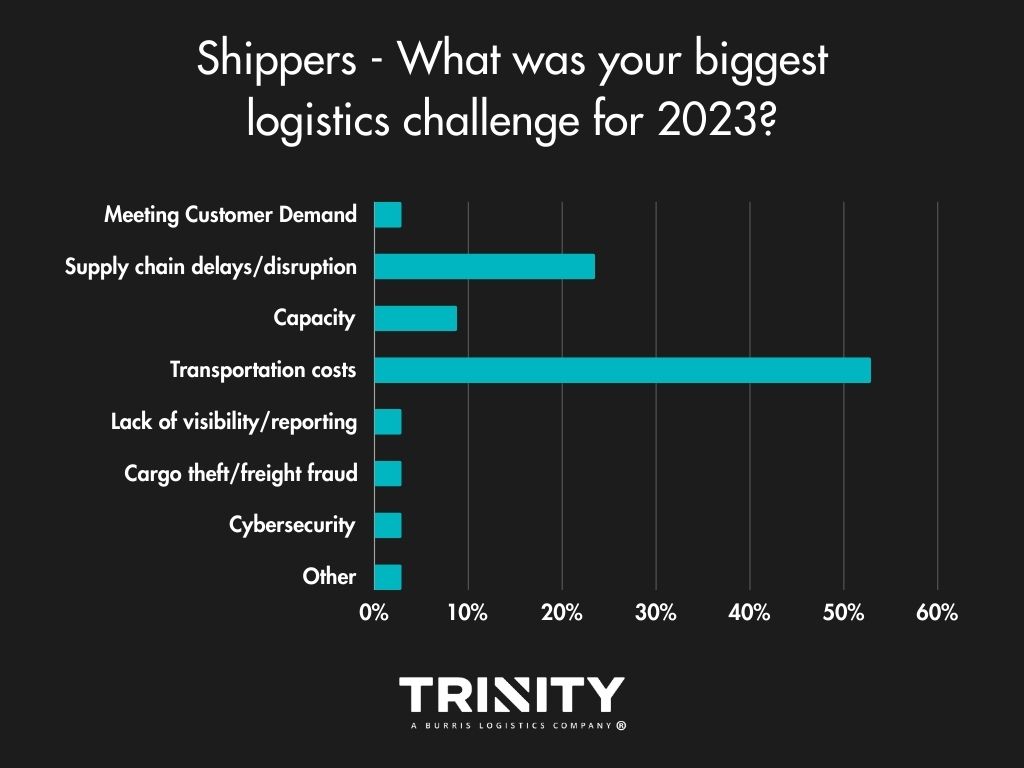
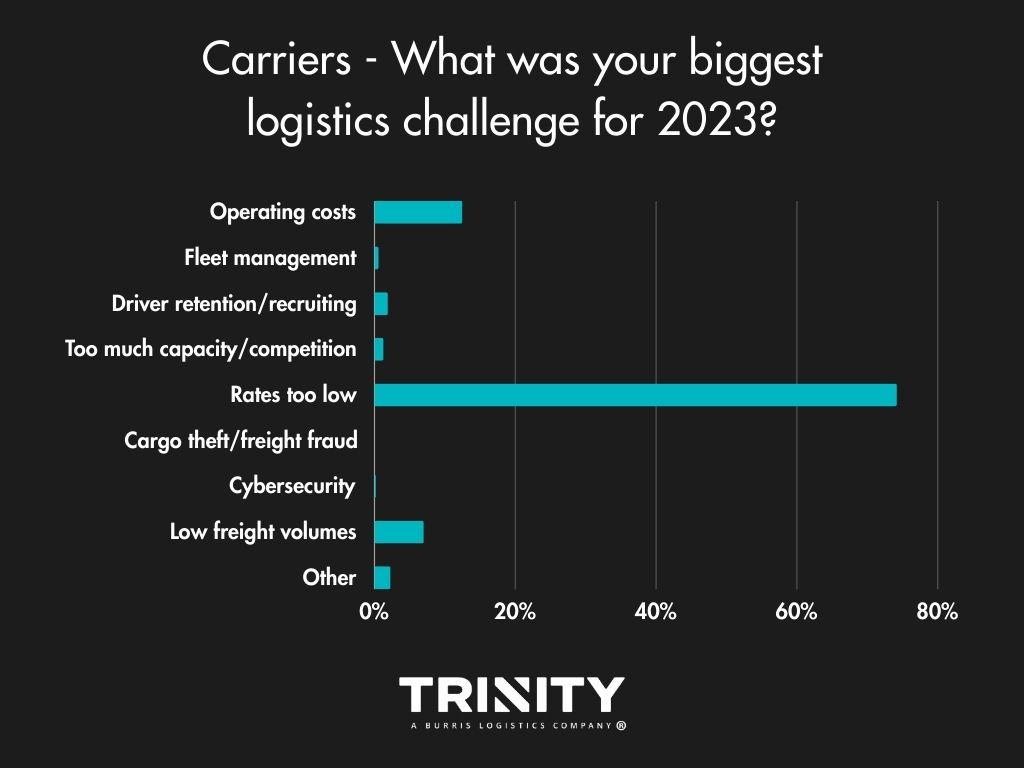
Business Impact – Could Have Been Better
Even with the change in consumer demand trending downwards throughout 2023, most shippers answered that their year was good overall. Carriers on the other hand seemed to face a rougher year in business with over half of them stating their year could have been better or was poor.
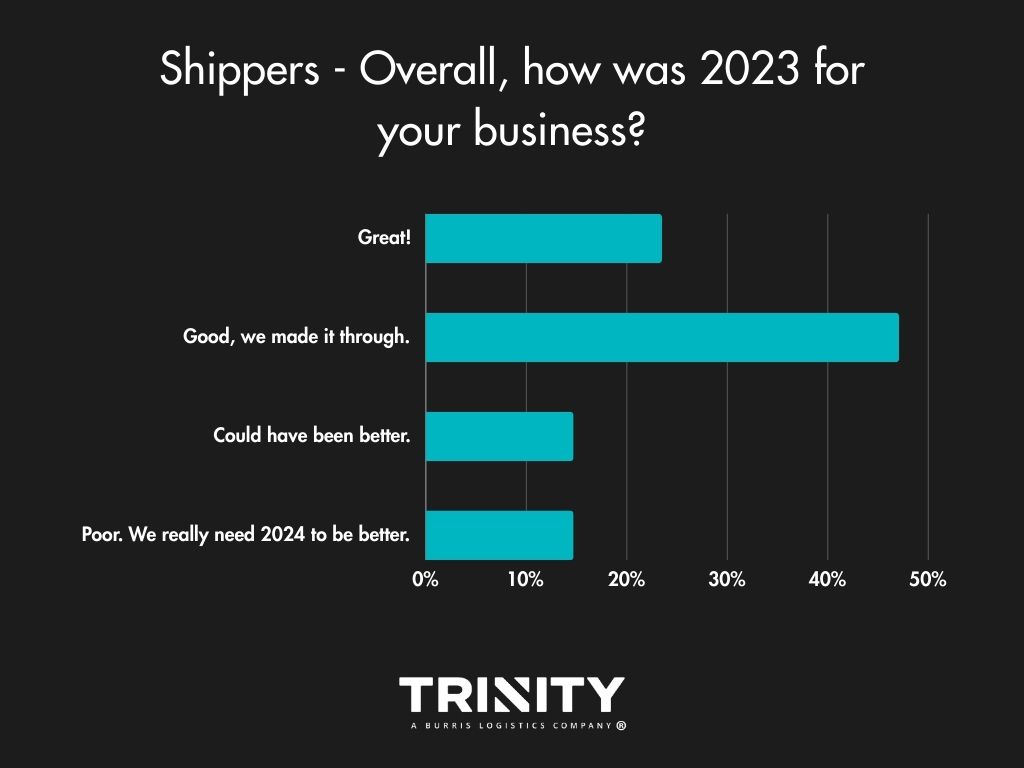
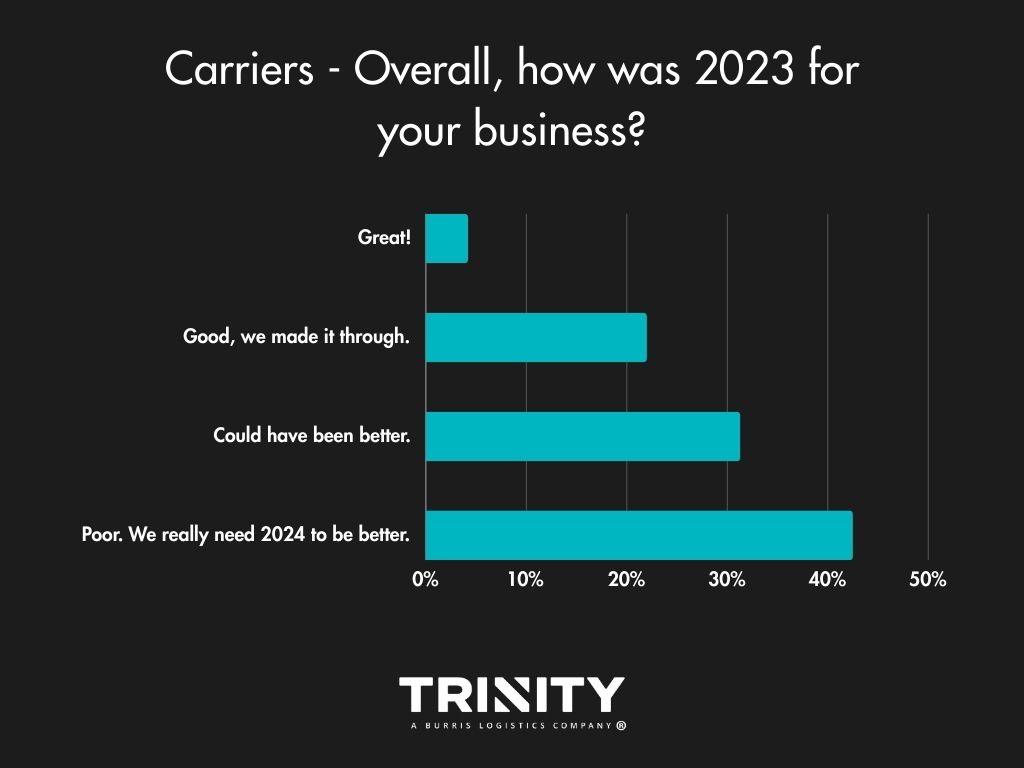
A LOOK INTO 2024
Future Challenges – Money Problems
2024 isn’t looking much different in terms of challenges compared to 2023. Shippers look to have the same financial challenges as they did in 2023 with transportation costs, supply chain delays/disruption, and decreased demand being the top concerns selected. Carriers are still concerned about low rates, operating costs, and low freight volumes hurting their businesses.


Hot Trends
Even though transportation costs are shippers’ strongest concerns in their previous answers, it seems the increased amount of supply chain disruptions and delays we’ve all experienced in these recent years have hit a nerve, with the majority answering that supply chain resilience is the trend their business is most interested in. Cybersecurity also looks to be a growing interest.
Carriers on the other hand, interestingly enough, look to the recent trend of Artificial Intelligence (AI). Also, as noted in the comment boxes of our “Other” option, increased rates and better fuel prices were trends they’d like to see in 2024.
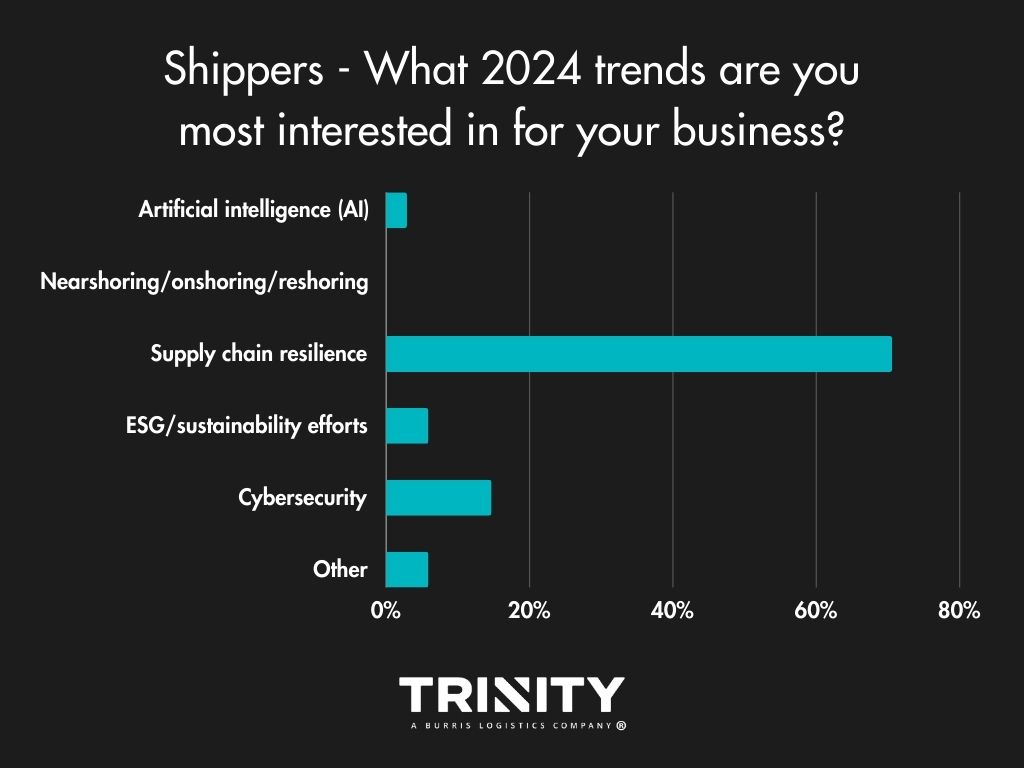
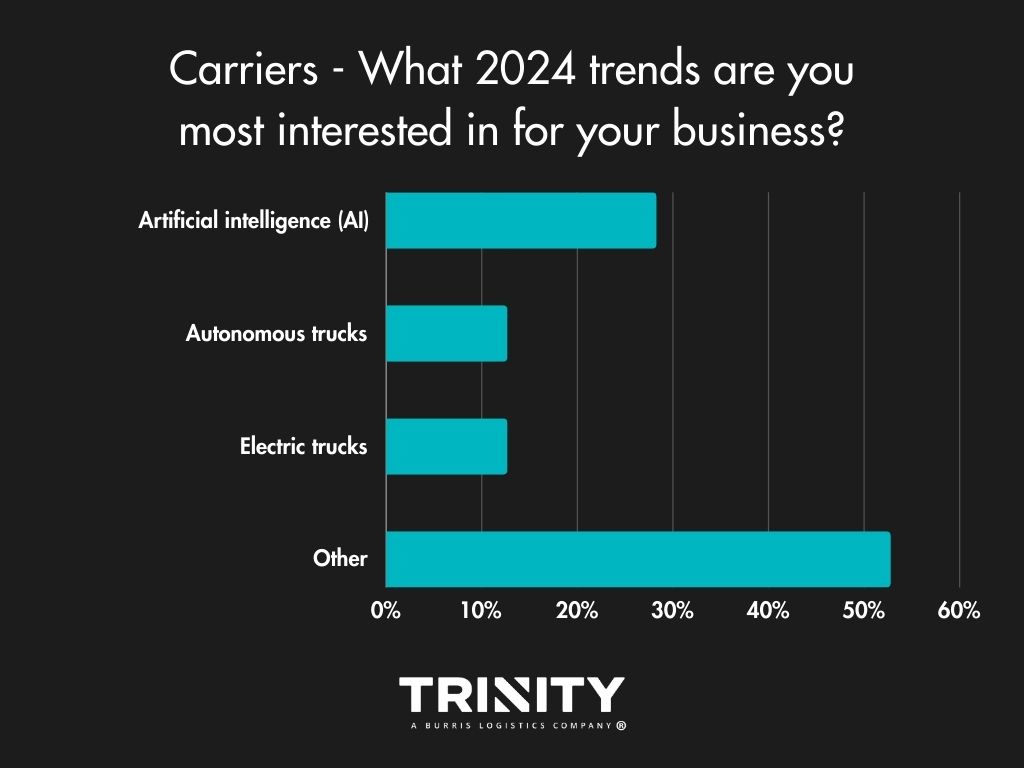
Load Volumes & Capacity – Slightly Positive Outlook
Overall, shippers are slightly more optimistic for 2024, thinking it won’t bring any change or the change it brings will be positive. Most think load volumes will stay the same or there will be a little more in freight volumes this year. As for truck capacity, they think it will be the same as 2023 or slightly tighter.
Carriers also think 2024 will bring more freight volumes and that capacity will likely stay the same or get tighten slightly versus 2023.
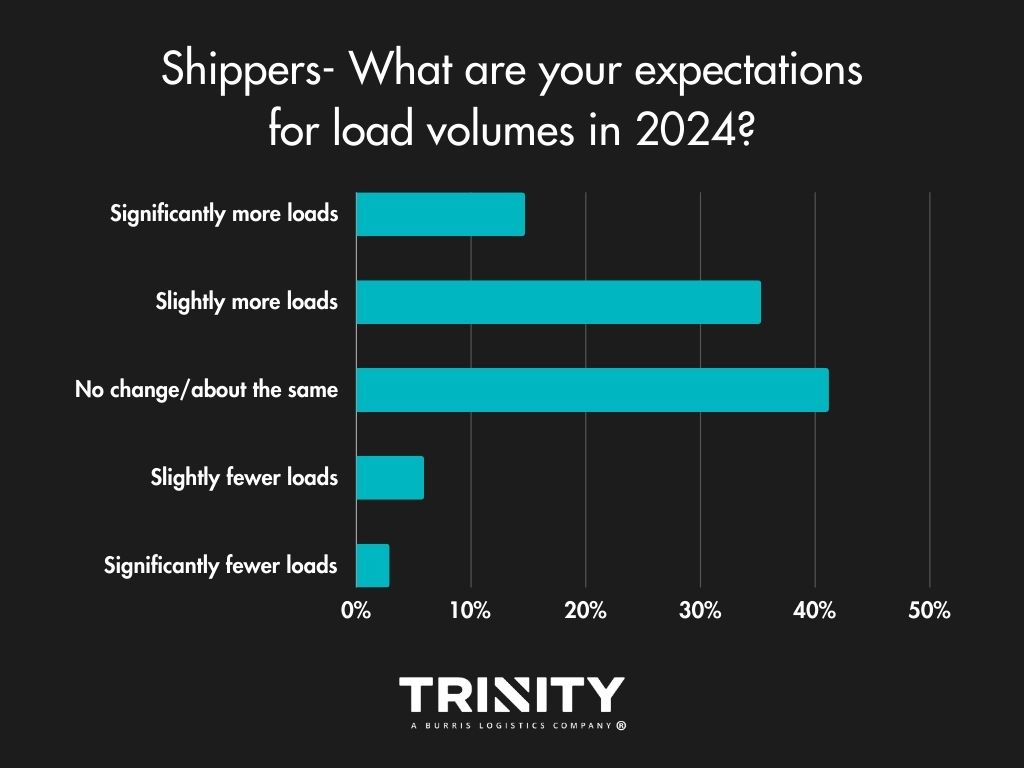
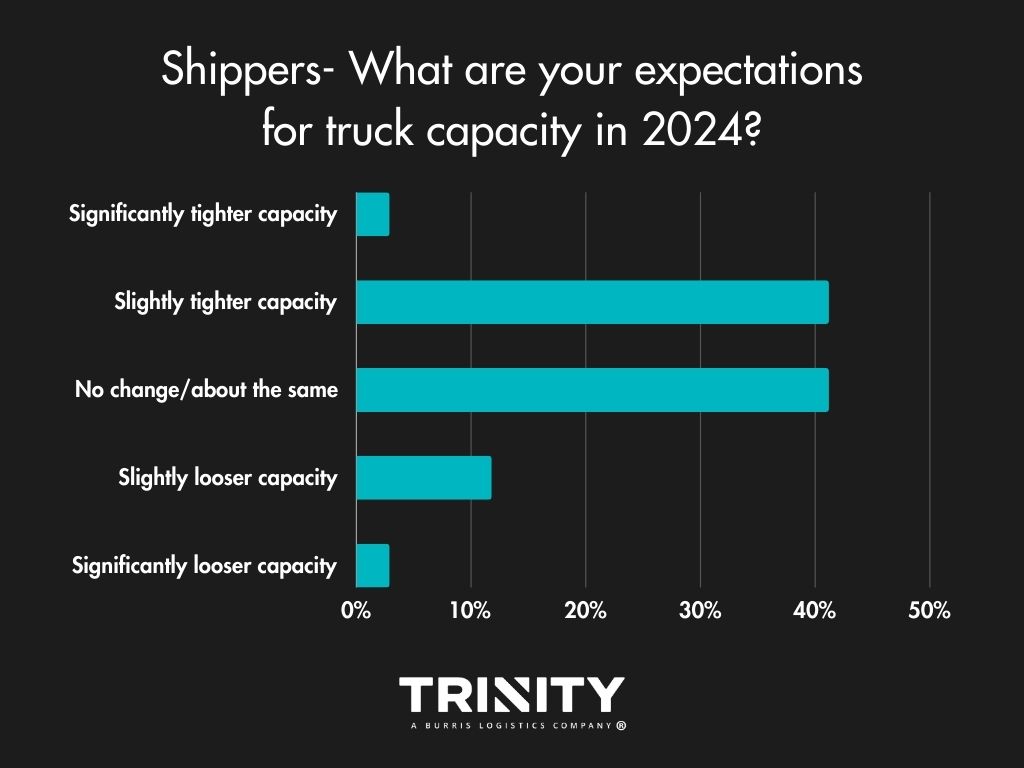
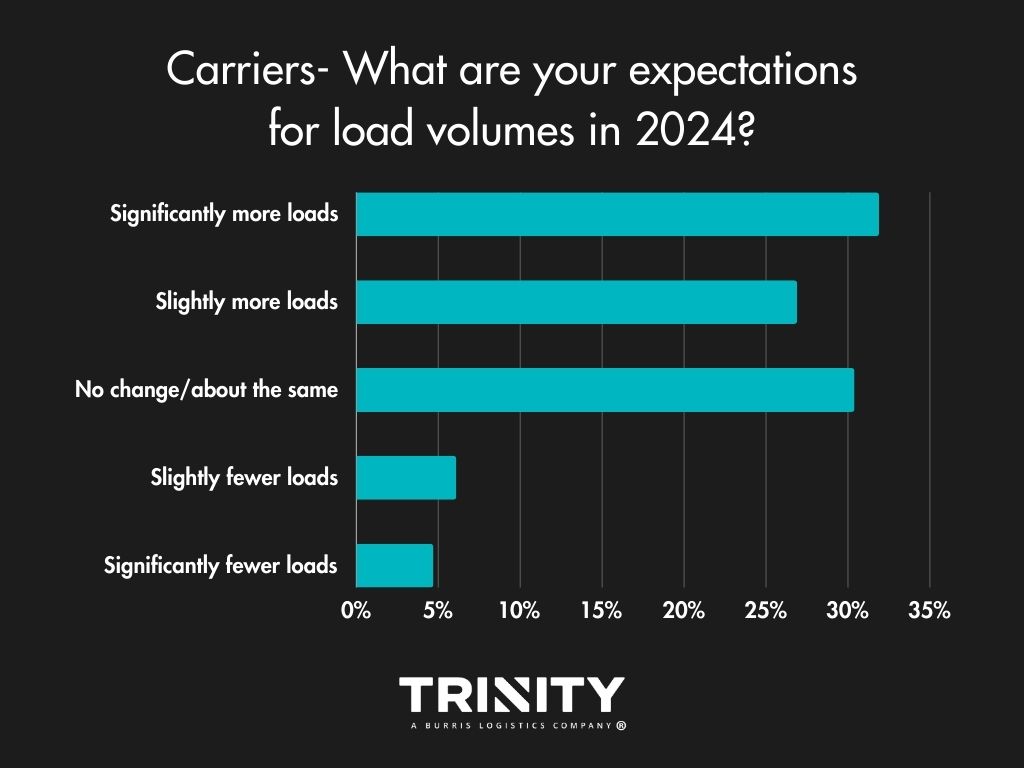
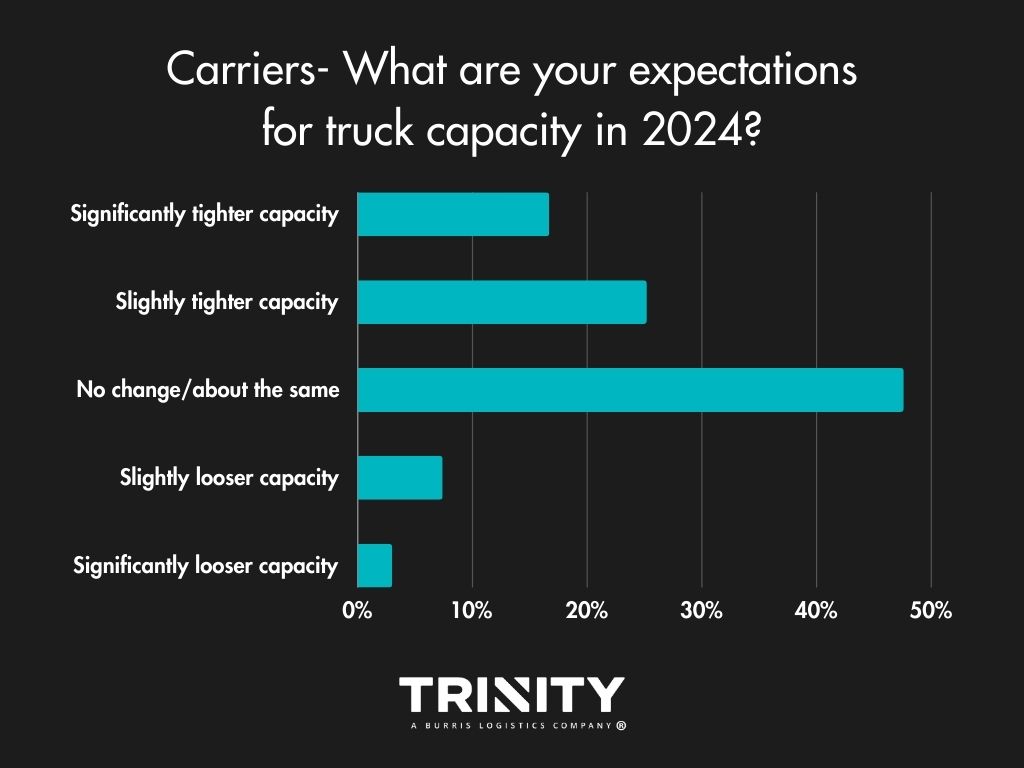
Spot or Contract?
Year-over-year, shippers aren’t looking to change much in terms of which market they turn to. Most look to continue to put most of their freight on the spot market.
For carriers, there looks to be some change anticipated. In 2023, most carriers ran spot market freight but in 2024, over half of them look to haul contracted freight.
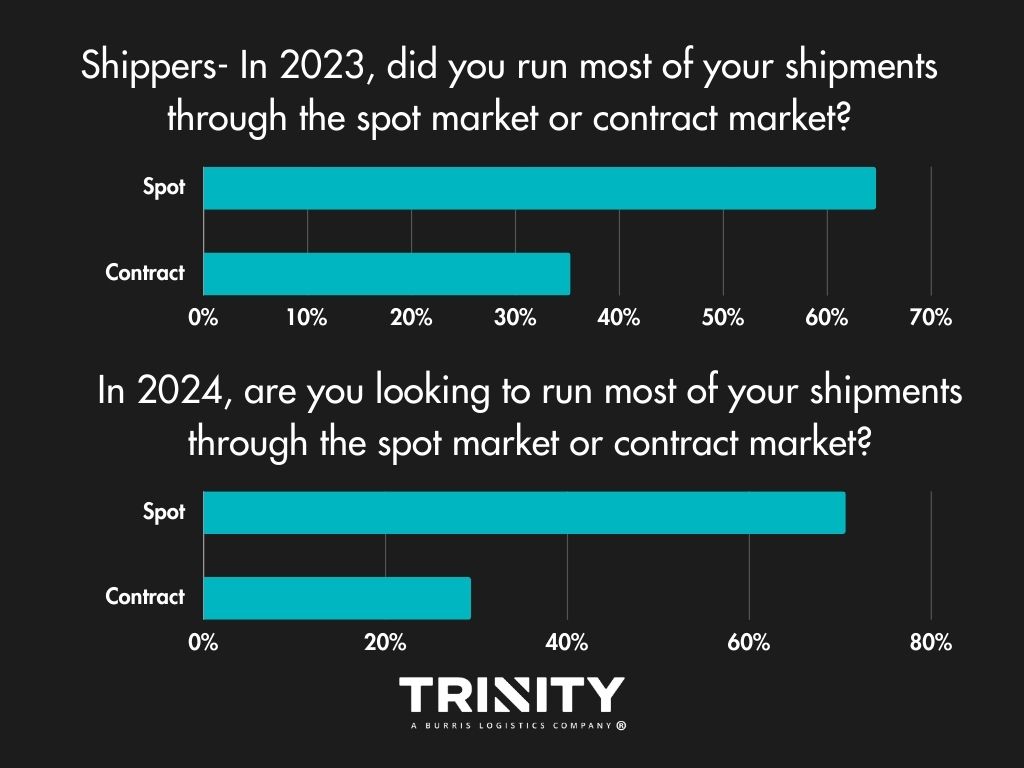
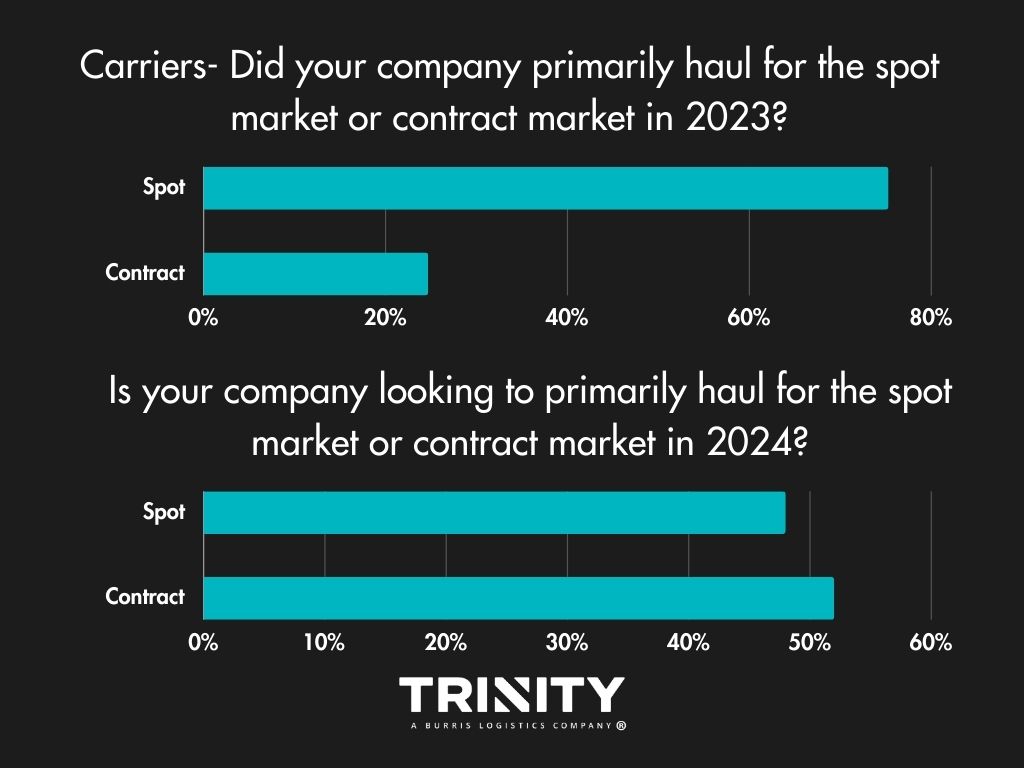
Do Shippers Have a TMS?
It’s 2024, so you’d think most shippers would have a transportation management system (TMS), and no surprise, they do. For those that don’t and answered, it seems they did not have a good experience with one in the past or don’t know enough about them.
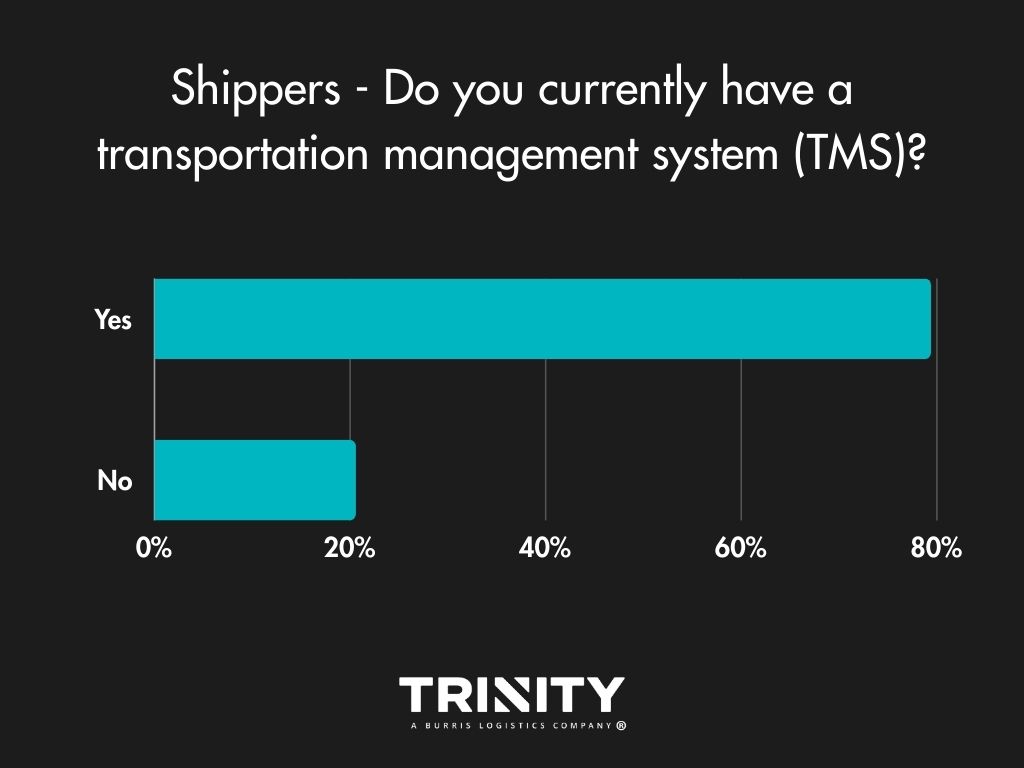
Brokers Are the Way to Go
When asked how they like to move their shipments, most shippers use a mix of carriers and third-party logistics providers (3PLs) or just 3PLs. A few do use their own trucks. For those that do outsource to 3PLs, they usually just stick to one provider.
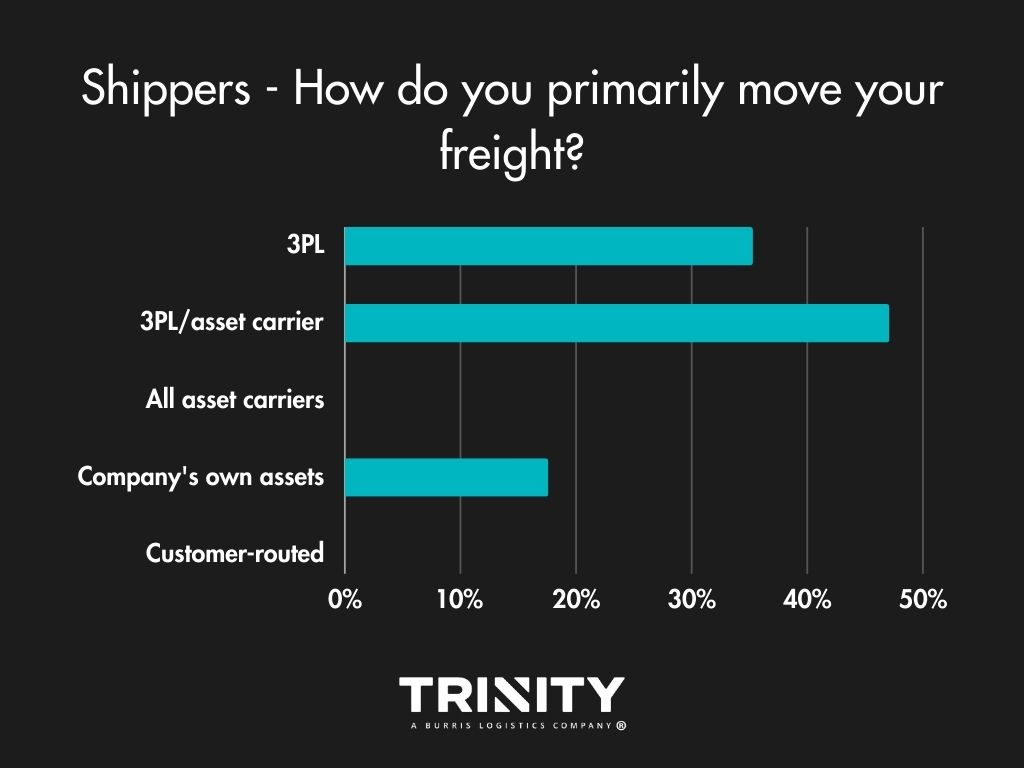
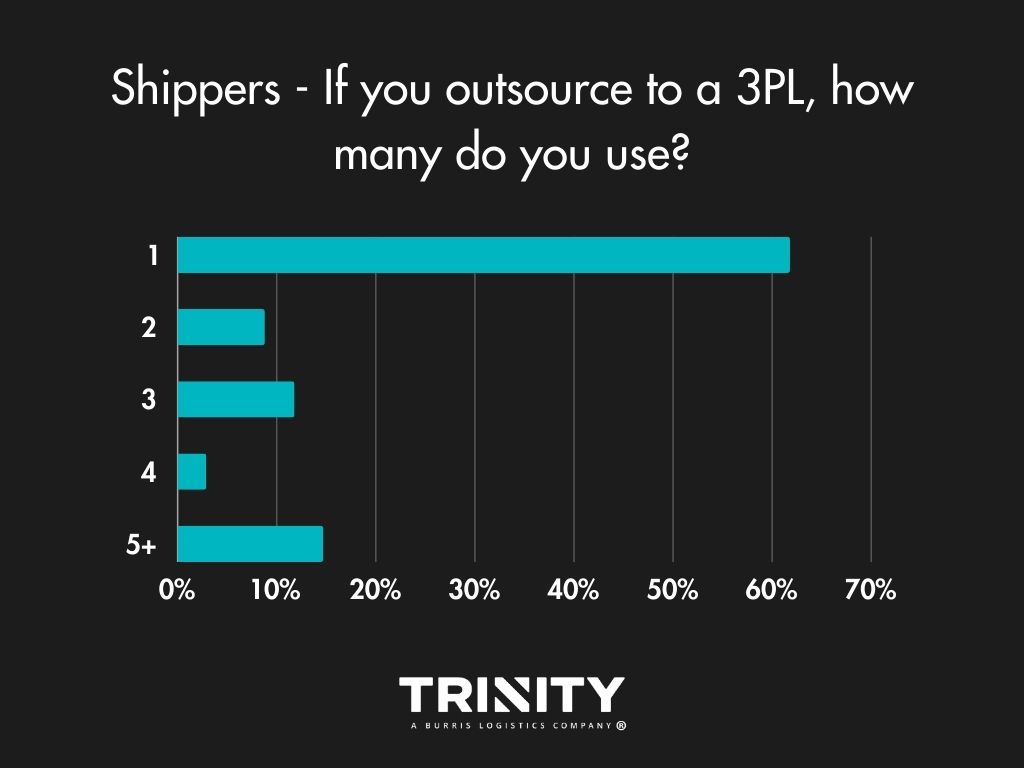
Shippers most often look to a 3PL for help with their everyday shipments, for transportation management, visibility, and access to their capacity. The main reason shippers choose not to work a 3PL for their logistics? They don’t like the risk.
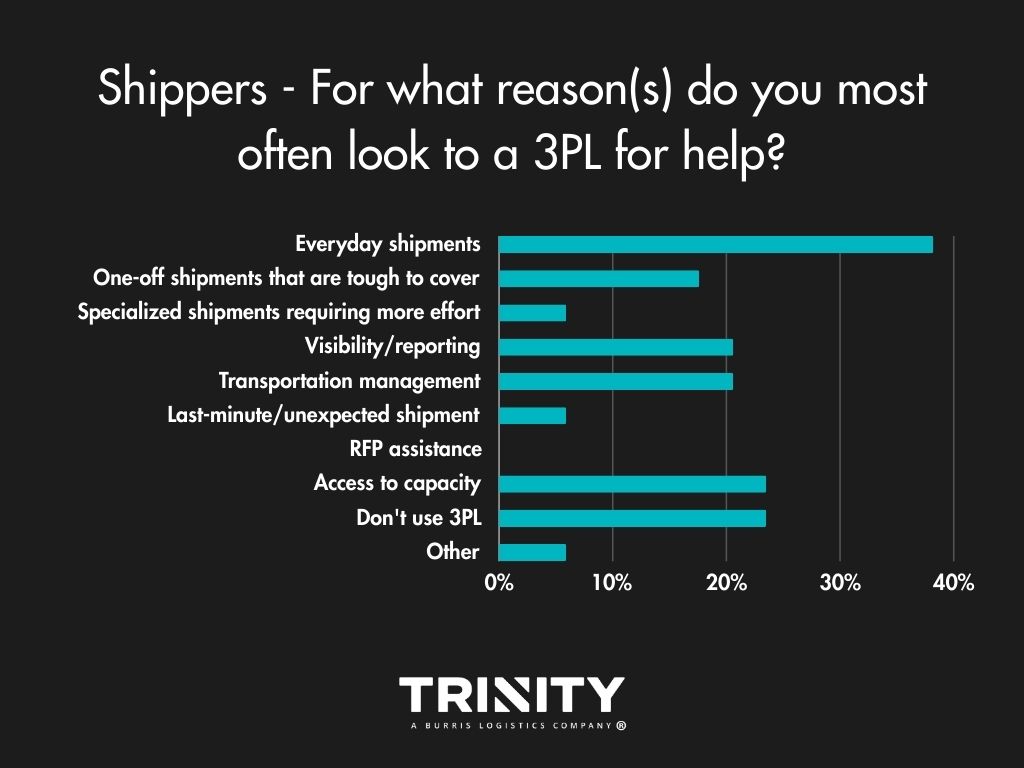
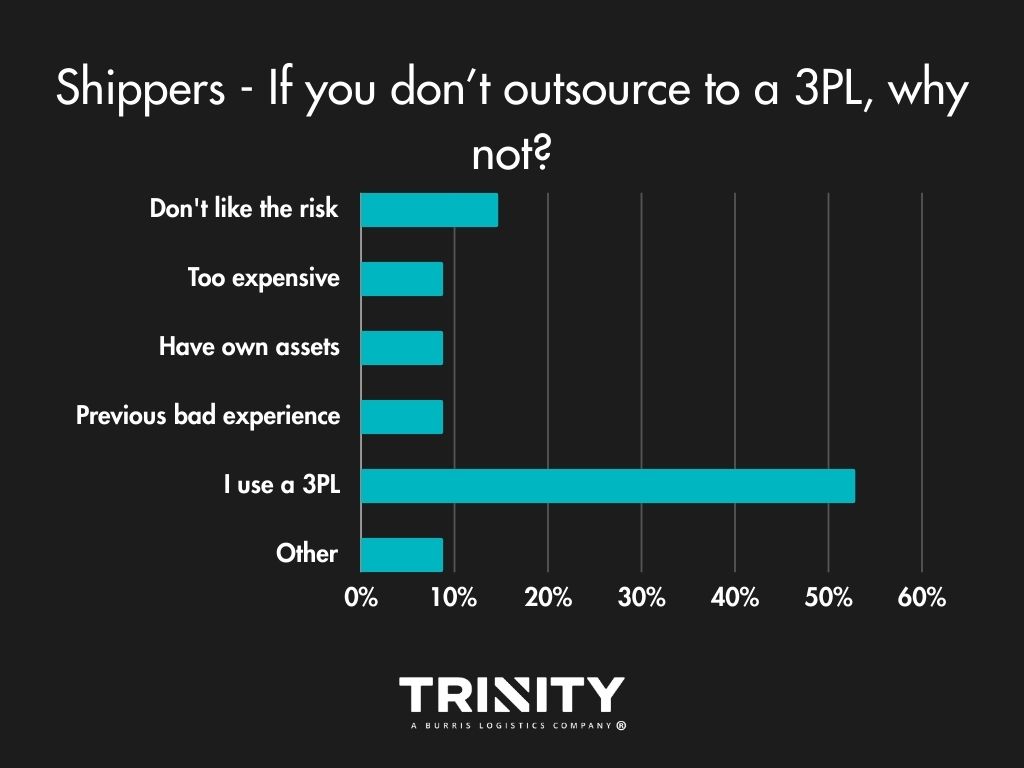
Transportation Modes – Staying Consistent
Overall, shippers aren’t looking to change what transportation modes they use for their shipments. Truckload and less-than-truckload (LTL) are the primary modes they like to use, with a little diversification sprinkled in.
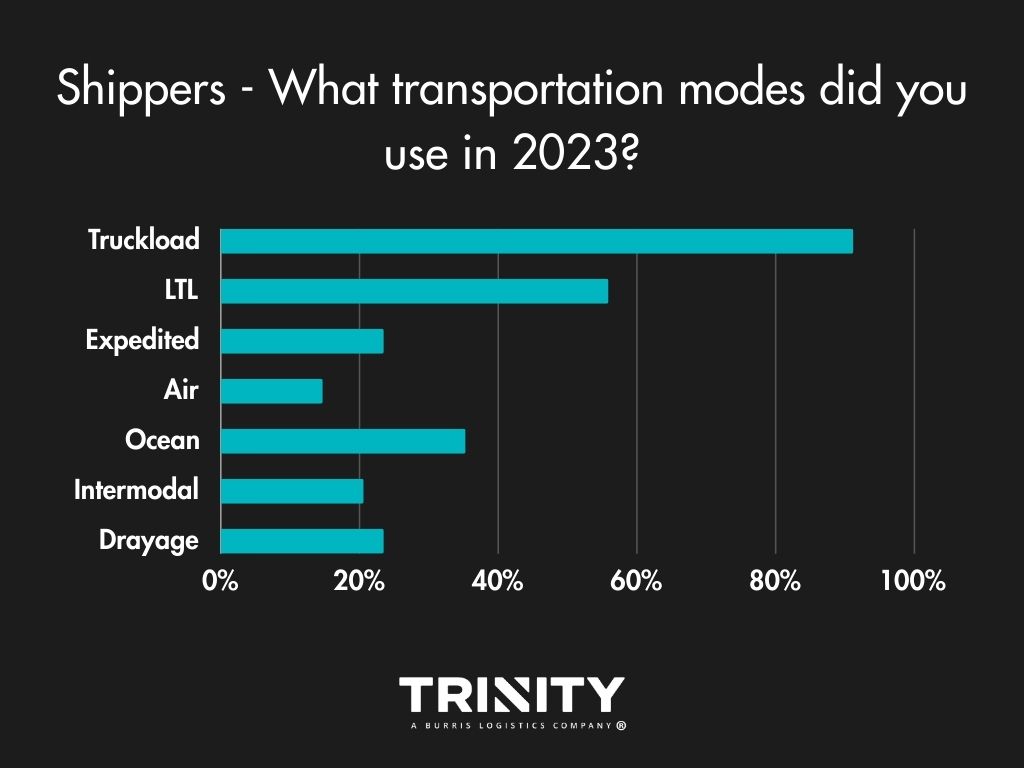
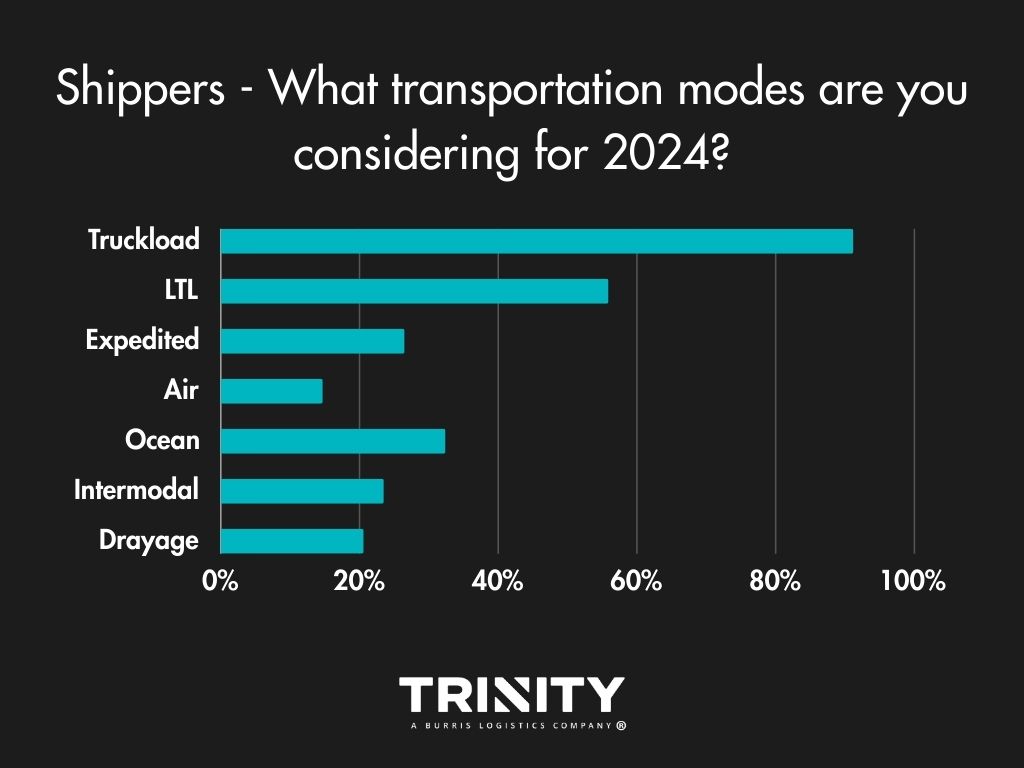
Exceptional Service Stands the Test of Time
When it comes to their logistics partners, shippers find the most value in receiving exceptional service, with costs coming in as a close second.
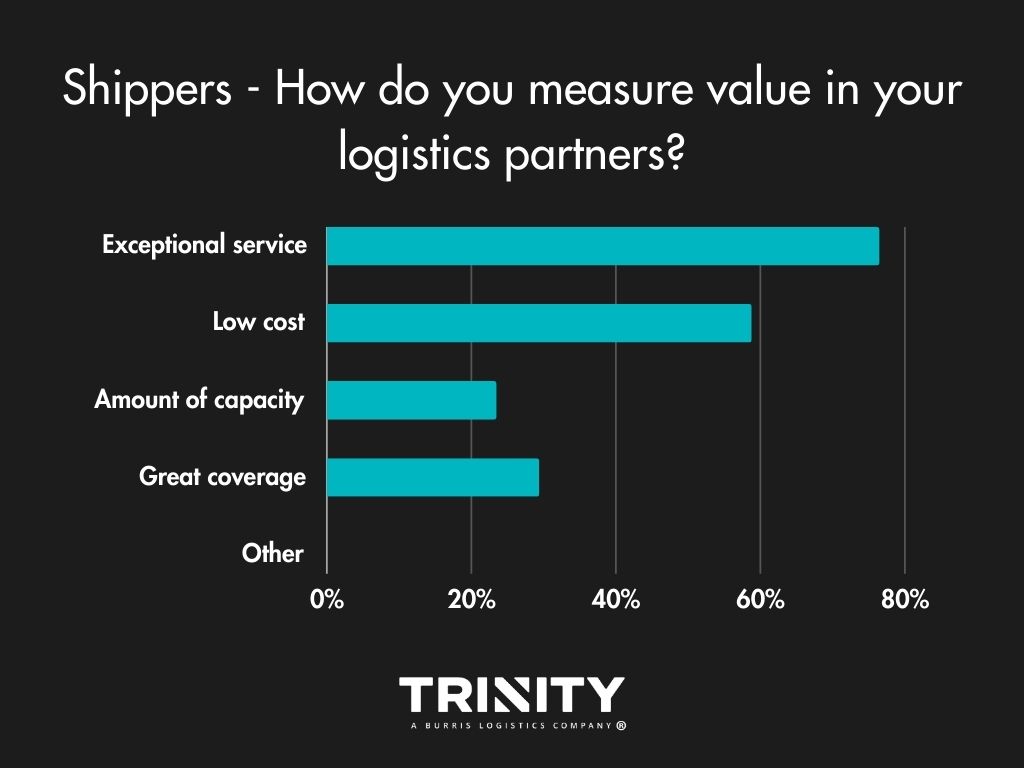
Most Wanted: Long Mileage, Flatbed Shipments
When it comes to mileage, most carrier companies tend to run long-hauls or a mix of short and long shipments. Flatbed hauls are the type of shipments most carriers like to haul with dry van coming in as a close second.
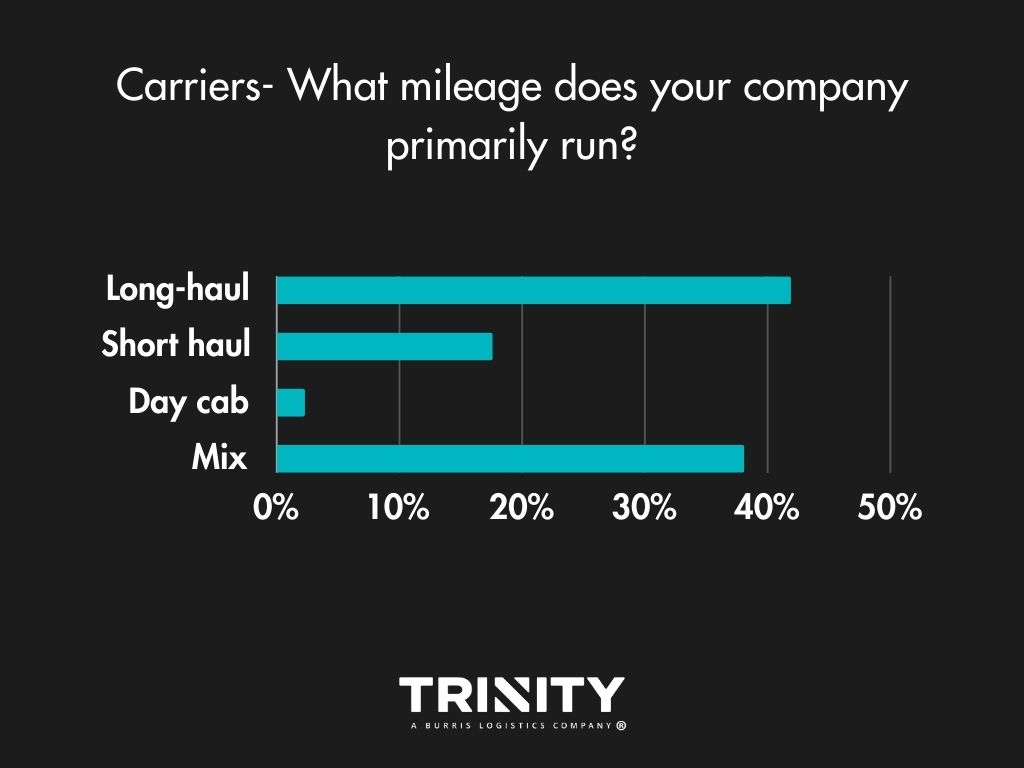
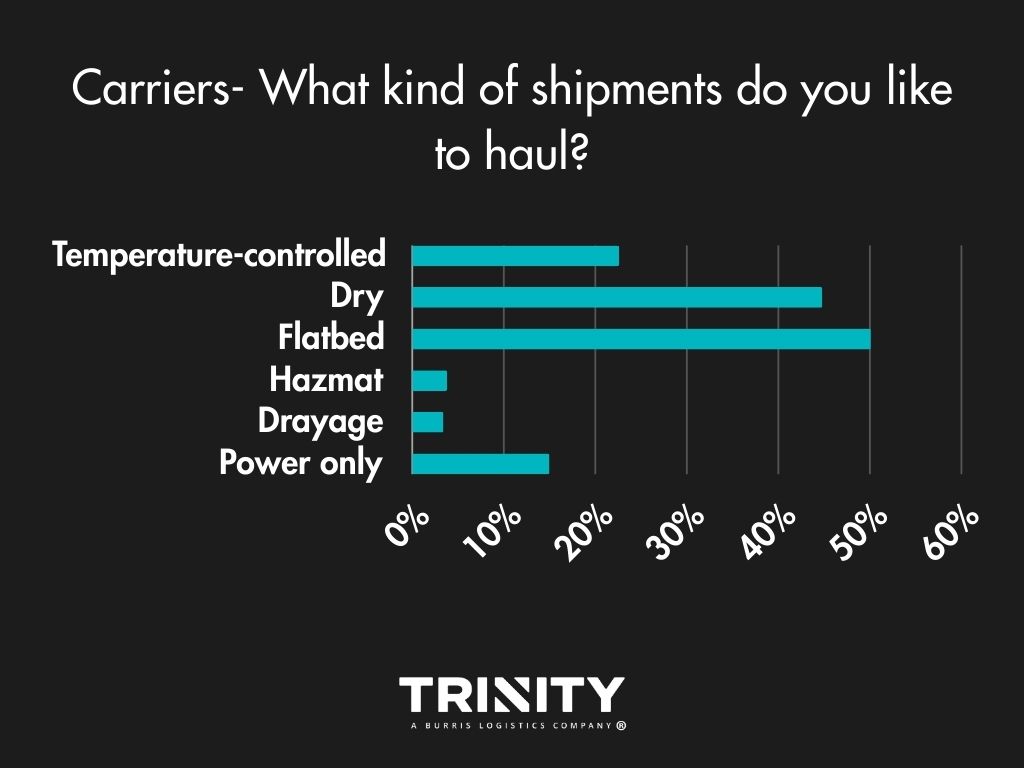
Load Boards are the Way
With 74 percent selecting this option, load boards are the norm for carriers to find available shipments. Sometimes they use their shipper relationships, and occasionally they make use of a 3PL.
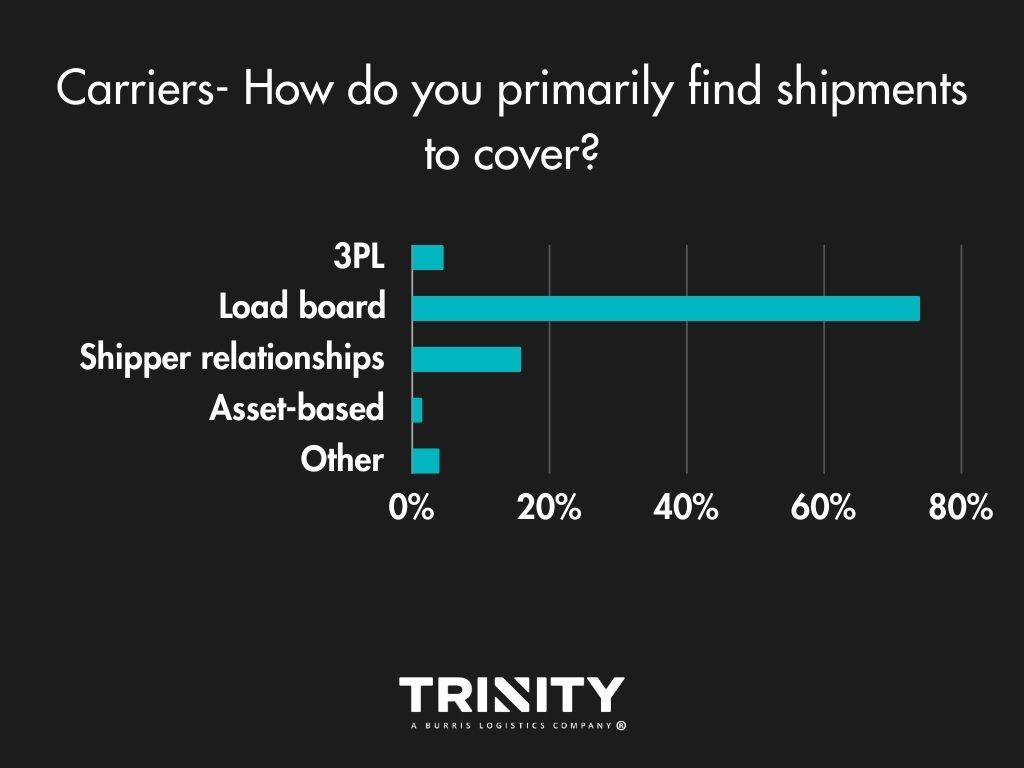
3PLs – Expanding a Carrier’s Reach
Carriers most often look to a 3PL for help with gaining access to available shipments that they wouldn’t have otherwise. Covering backhauls are another big reason carriers reach out to a 3PL.
For those that choose to not work with a 3PL, it’s often because of money; rates not being high enough. Surprisingly in the comments, many are not familiar with what a 3PL or freight broker is as well.
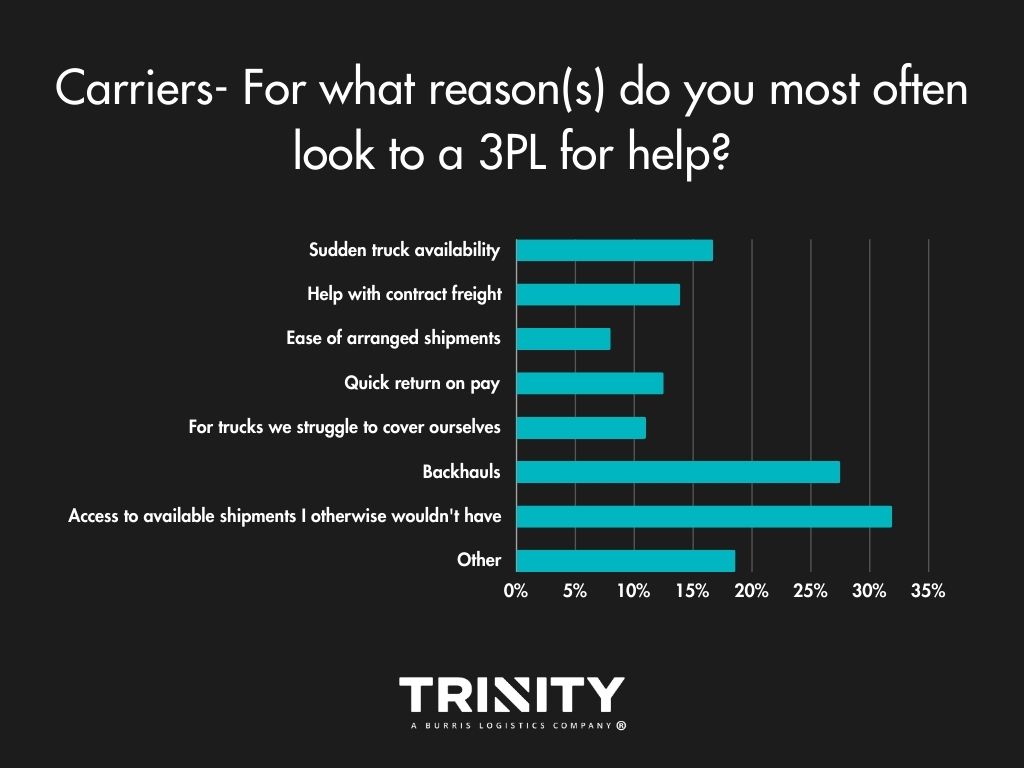
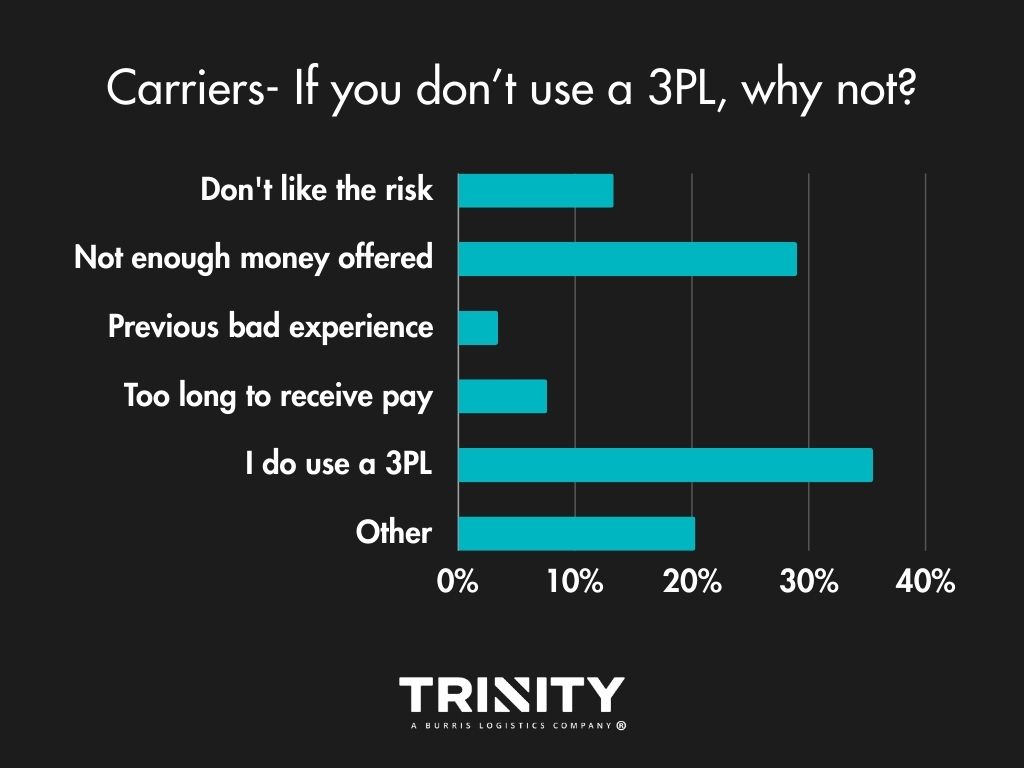
When it comes to measuring value in their 3PL partners, most carriers want good rates and great communication.
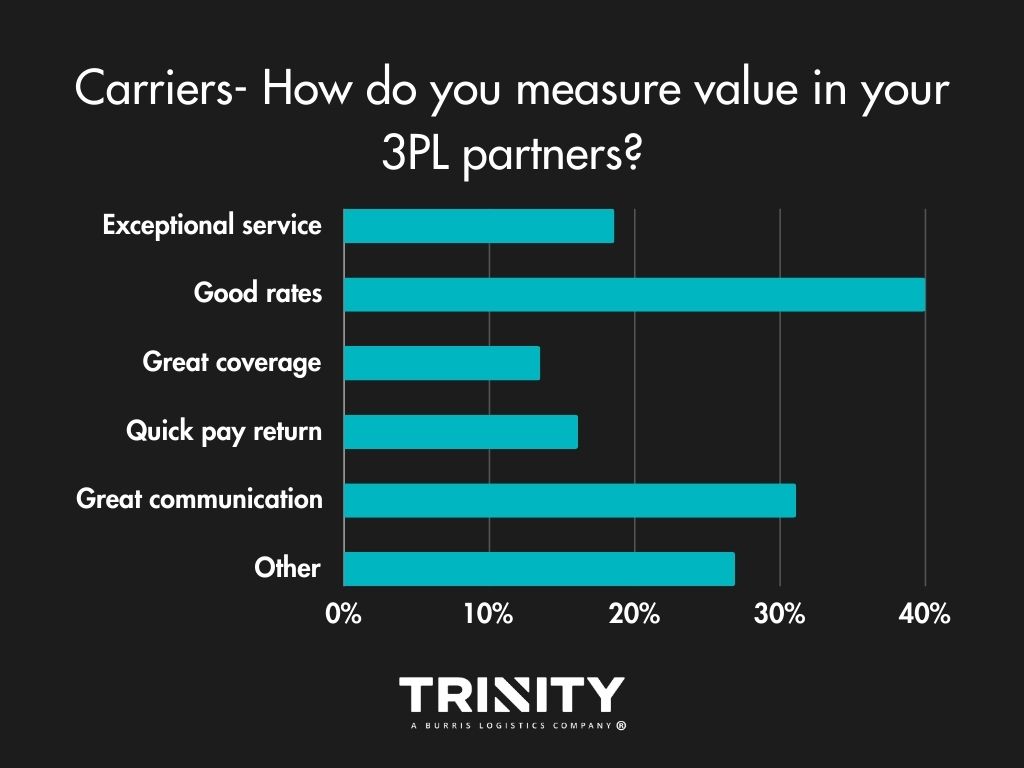
Fraud Concerns Growing
Fraud and scams have been growing in the industry, so we wanted to know what carriers think about it. Carriers are most worried about double and triple brokering affecting their businesses compared to concerns of identity theft or cargo theft.
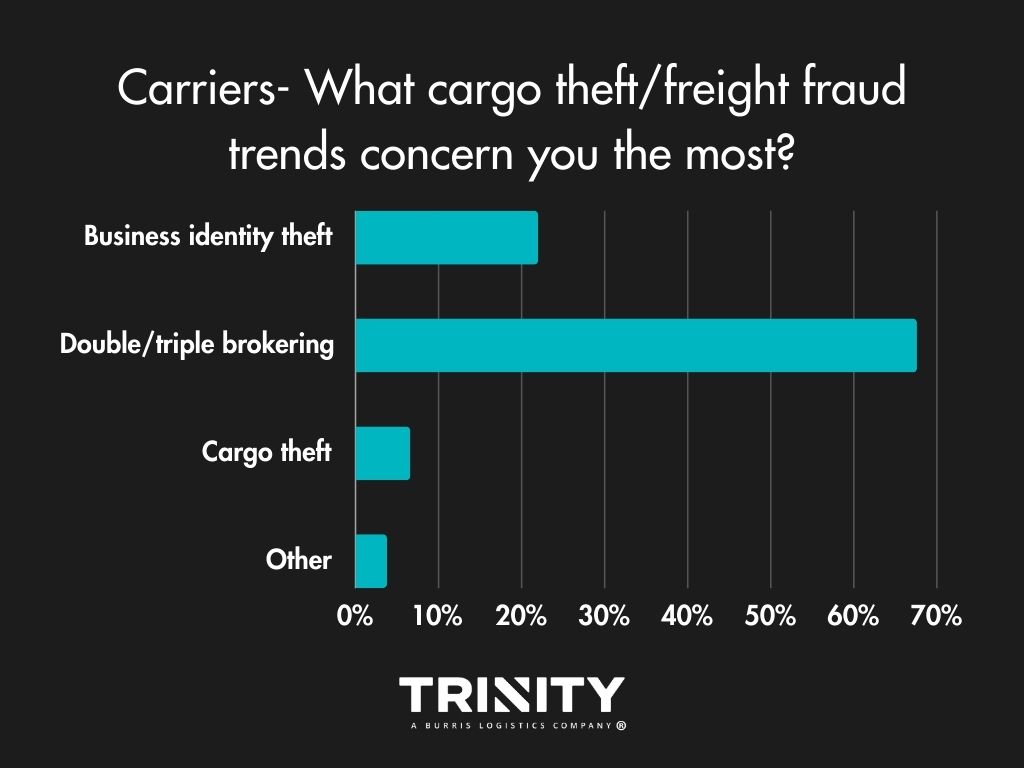
Successful goal-setting is a necessity for Freight Agents to run prosperous businesses. If you’re feeling stuck with your goal setting, the Fresh Start Effect could help you achieve what you want.
If you perform a web search on the “Fresh Start Effect”, you’ll find a lot of articles and studies on the impact that a Fresh Start Date has on goal setting.
What is a Fresh Start Date?
It’s a date that signifies a clear end and a new beginning. New Year’s Day is the epitome of a fresh start date because you’re ending one year and starting a new one. However, a Fresh Start Date doesn’t have to be as well known as New Year’s Day. It can be any day that signifies a new beginning such as your birthday, Mondays, the first day of a new month, etc.

Why Is a Fresh Start Date Important in Goal-Setting?
Studies show that people are more likely to commit to their goals when centered around a Fresh Start Date. It gives a boost to let go of the past, whether it’s a behavior that you would like to let go of or a new behavior that you would like to start.
Tips for Freight Agents to Achieve Their Goals
If you’re looking to really set yourself up for success when setting your goals, here are some tips you can put into place.
1. Set Your Fresh Start Date
Choose your Fresh Start date to give yourself an extra chance at committing to your goal!
2. Make It S.M.A.R.T.
Using this tried-and-true goal setting method can help you become specific in what you are trying to accomplish. Make sure your goals are specific, measurable, attainable, realistic, and timely, giving you a greater chance at seeing success.
3. Know Your Why
Make it personal. Why is this goal important to you? How will your life look different when it is accomplished? Goals that don’t have a personal why behind them can seem arbitrary and make it very easy to quit.
4. Write It Down and Share It!
Writing down your goal in a place that you can see often, such as a daily planner, helps keep you focused on the goal. Having someone else aware of your goal also helps you stay accountable to yourself!
5. Plan Ahead
This is the beauty of a Fresh Start Date. By knowing when you are going to start, you can put in the work ahead of time to close out your current chapter and begin the new one. Whether it’s transitioning and delegating responsibilities or researching and learning so that you can hit the ground running on your fresh start date, having some pre-planning time will allow you to focus on the goal ahead.
6. Celebrate!
Having a significant reward or way to signify the achievement of a goal can help maintain motivation. For example, one goal that many of Trinity’s Independent Freight Agents have each year is to achieve Platinum status. This is a designation set aside for Agents that hit production goals in a calendar year. The reward for our Platinum Agents is an all-expense paid vacation for two! It’s a great way to recognize success, celebrate, and network with other Platinum agents so that you can start getting motivated for the next year!
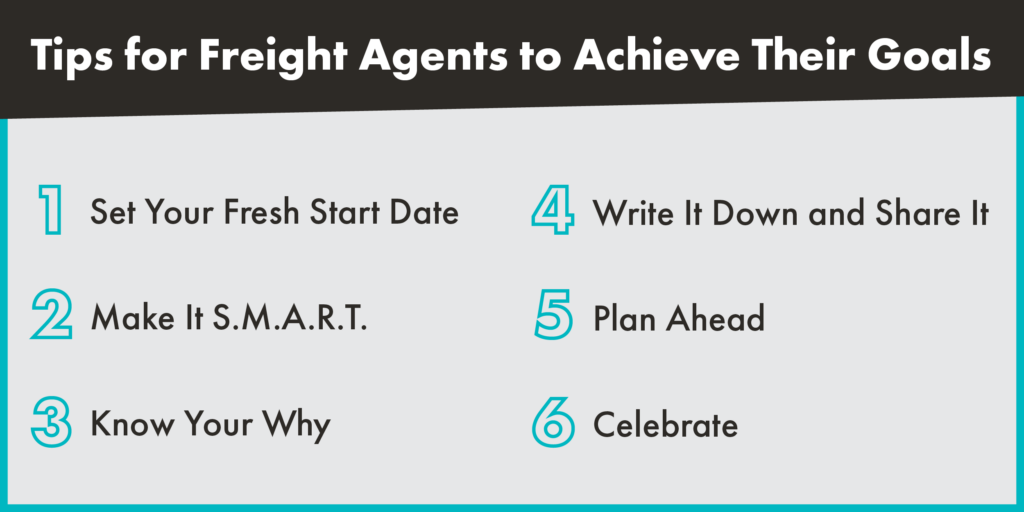
One thing many people forget is that goals don’t just have to be professional; they can be personal, too. Whether you want to strengthen your relationships or learn a new skill, use these tips to get yourself there.
How Trinity Helps Freight Agents Get a Fresh Start for Their Business
At Trinity, we plan our goals around our monthly periods. This gives us the opportunity to evaluate regularly to ensure that we are staying on track and adjust quickly if needed. With our Independent Freight Agents, we work with them based on their personal business needs. Depending on the particular goal of a Freight Agent office, we may review these monthly, quarterly, or annually.
For instance, many of our Agents set the goal to achieve Platinum Agent status. Because of this, we have a Platinum Agent tracking tool that we can send out at any time to help them track their progress toward this important goal.
A Fresh Start Date is just one tactic to setting your Freight Agent business up for success and always a great time to re-evaluate your current brokerage partner. In fact, Freight Agents who partner with Trinity Logistics often see an average of 20 percent growth within their first two years of joining.
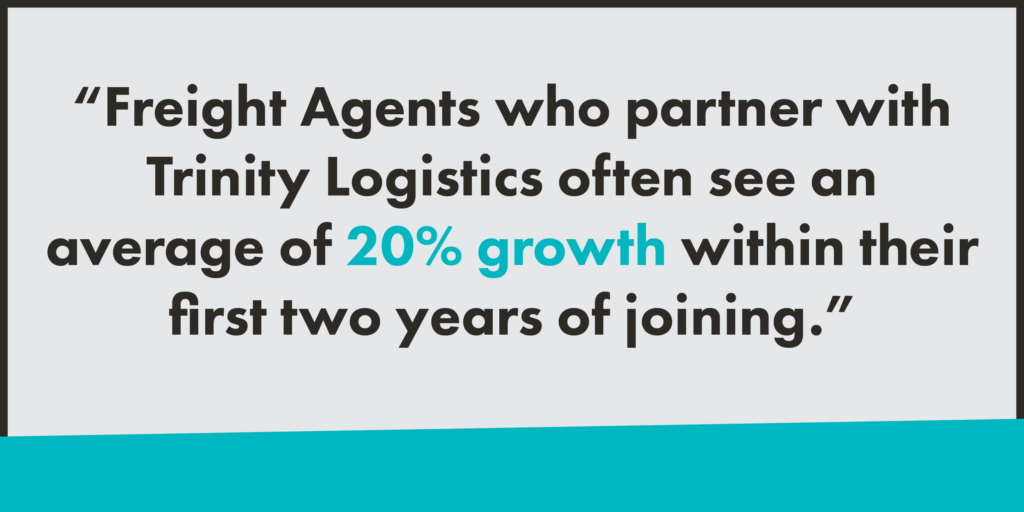
Check out the details of Trinity’s Freight Agent program to see if making a change at your next Fresh Start Date may be right for your business.
LEARN MORE ABOUT TRINITY’S FREIGHT AGENT PROGRAM